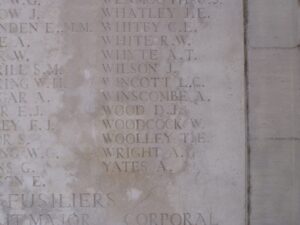Within the confines of St. Katherine’s Church at Milford Haven is a wide array of memorials to local servicemen who fell during the Great War.
The Church holds a memorial sedilia to William Sanders, VC, and several fine stained-glass windows; one in memory of Lieutenant Edmund Sydney Howells who fell during WW1 and another in memory of Lieutenant-Commander Frederick Harold Williams, who fell during WW2. A framed religious picture bears the name of Lieutenant Tom Cecil Haydn Berry, who fell in France in 1918, while there is a separate plaque for William Thomas Prior.
The Rood Screen also serves as a War memorial, being carved with the names of the parishioners who fell during the Great War. There is also a fine parchment memorial book, bearing the names of the men who fell during World War Two. All of these men are commemorated on the main Milford Haven War Memorial on Hamilton Terrace.
The most striking of the memorials within the Church is the Altar of Remembrance, which is the centrepiece to a collection of original wooden grave markers from battlefield cemeteries in France, Belgium, Iraq, and at Milford itself. These markers were collected by Canon Edmund Howells, whose own son Edmund had been killed during the war, after the CWGC replaced the crosses with the now familiar carved Portland Stone headstones in the 1920’s, and were dedicated at a service in the Church in July 1924.
This page commemorates the parishioners of St. Katherine’s Church who fell during the Great War and who are commemorated on the Rood Screen within the Church. The screen was unveiled and dedicated at a ceremony in the Church on Sunday 16 June 1919, which was attended by over 1,000 people.
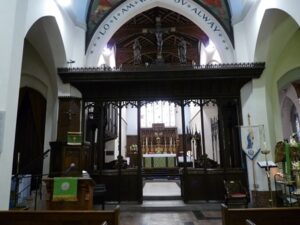
The Great War, 1914-1918
Thomas Anderson, Engineman, 380ES, Royal Naval Reserve. Thomas was born on 20 September 1880, the son of James and Mary Anderson, of Aberdeen. For many years prior to the war he had lived with his wife Annie Anderson, at 21, Murry Road, Pill, Milford Haven. Thomas served as Engineman aboard HM Trawler Loch Eye, and drowned when she struck a mine near Dunmore, off the coast of Ireland on 20 April 1917. Thomas was 36 years old, and is commemorated on the Plymouth Naval Memorial, Devon.
John Edwin Anthony, Trimmer, 546TS, Royal Naval Reserve. John was born on 24 November 1890, the son of John and Elizabeth Anthony, of Hubberston, Milford Haven. He married Beatrice Maud Battensby in 1913, and the couple resided at Hubberston Green. He served as Trimmer aboard HM Trawler Drumtochty, which was used to patrol the English Channel. John was killed on active service on 5 March 1916, aged 28, and is buried at Dunkirk Town Cemetery. Drumtochty sank later in the war when she struck a mine in the Channel on 29 January 1918, with the loss of eleven of her crew of thirteen.
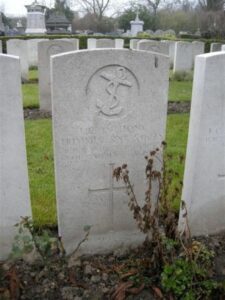
Joseph Houghton Ashton, Engineman, 147TS, Royal Naval Reserve. Joseph was born on 28 July 1885, the son of William and Elizabeth Ashton, of Liverpool. During the war he lived with his wife Ellen Ashton, at 3, Brick Houses, Pill, Milford Haven. He served as Engineman aboard HM Trawler Carew Castle, and was killed when she struck a mine off Hartland Point on 12 June 1917. Joseph was 31 years old, and is commemorated on the Plymouth Naval Memorial, Devon.
Charles Ernest Badrick, Sergeant, 50140, Royal Engineers. Charles was born in 1882, the son of Joseph and Rebecca Badrick, of 7, Green Terrace, Hubberston, Milford Haven. He enlisted at Milford into the Royal Engineers, and was posted to their 98th Field Company, which was on the Western Front, attached to the 21st Division. The Division crossed to France between 2 and 13 September 1915, and its first experience of battle was truly appalling. Having been in France for only a few days, lengthy forced marches brought it into the reserve for the British assault at Loos. GHQ planning left it too far behind to be a useful reinforcement on the first day, but it was sent into action on 26 September, whereupon it suffered over 3,800 casualties for very little gain. The Division remained in the area north of Loos over the coming winter, and it was here that Charles was killed in action on 1 December 1915, aged 33. Charles is buried at Chappelle-D’Armentieres New Military Cemetery, France.
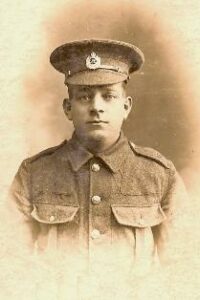
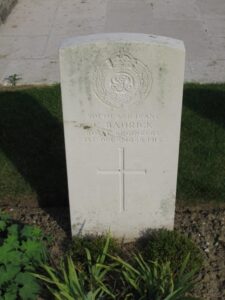
William Walter Berryman, MID, Deck Hand, 208DA, Royal Naval Reserve. William was born at London on 1 April 1886, the son of William James Berryman and Eliza Jemima Berryman. Prior to the war he resided with his wife, Ellen Holtby Berryman, at 122, Robert Street, Milford Haven. William served as Deck Hand aboard HM Trawler Apley, and had been Mentioned in Despatches during his time at war. He was killed on 6 December 1917 when Apley struck a mine off the Isle of Wight. William was 32 years old, and is commemorated on the Plymouth Naval Memorial, Devon.
Thomas Frederick Bevans, Private, 48852, Lancashire Fusiliers. Thomas was the son of John and Mary Ann Bevans, of 15, Albion Street, Milford Haven. He had enlisted at Carmarthen into the army, and was posted to the 1st Battalion, Lancashire Fusiliers, part of 86 Brigade, 29th Division. The Division moved to Gallipoli via Egypt, landing on 25 April, 1915. They remained here until evacuation to Egypt on 11 January, 1916 and then moved to the Western Front on 15 March 1915. The Division took part in its first major action in France during the 1916 Somme Offensive, and fought at the Battles of Albert and Le Transloy, suffering heavy casualties. In the Spring of 1917 they fought at the Battle of the Scarpe, which was part of the Arras Offensive, and then moved further north to Ypres. Here they fought at the Battle of Langemarck, and then at the Battles of the Menin Road, Polygon Wood, Broodseinde and Poelcappelle, before moving to Cambrai. Here they fought at the Battle of Cambrai in November and December, 1917 before moving back to Flanders early in 1918. The German Spring Offensive hit the British on the Somme on 21 March, 1918, and hit in Flanders just weeks later. The 29th Division fought at the desperate defensive battles of Hazebrouck, which is where Thomas was killed in action on 12 April 1918. He was just 20 years old, and is commemorated on the Ploegsteert Memorial, Belgium.
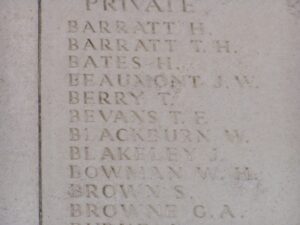
Stanley Thomas Bowen, Sergeant, 11, Welsh Regiment. Stanley was the only son of Alfred and Hannah Bowen, of Prendergast, Haverfordwest, and was the husband of Gertrude Clarke. He enlisted at Haverfordwest into the 4th Welsh prior to the outbreak of war, and by the outbreak had been promoted Serjeant. The battalion formed part of the Territorial Force, and was reformed for war in August 1914, becoming attached to 259 Brigade, 53rd (Welsh) Division. The Division moved to the Mediterranean, sailing from Devonport in July, 1915 arriving at Mudros by 5 August 1915. From here they moved to Gallipoli, landing on 9 August. Here the division was immediately thrown into action, and spent the next few days in isolated pockets, fighting against a Turkish counter-attack during the Battle of Sari Bair, and then at the Attack on Scimitar Hill. Stanley was one of several hundred casualties within the 4th Welsh during these first few days on Gallipoli. He was killed in action on 10 August 1915 aged 29, and is commemorated on the Helles Memorial. His widow later remarried, and became Gertrude M. McNeill, of Erindale, Ontario, Canada.
William Henry Broome, Engineman, 83ES, Royal Naval Reserve. William was born on 20 November 1885, the son of Mary Elizabeth Broome. He married in 1908, and lived with his wife Annie Jane Broome, at 219, Robert Street, Milford Haven. William was brought up by his grandparents under his mother’s maiden name of Thomas, because she was in service, so he served with the Royal Naval Reserve as William Thomas, as an Engineman aboard HM Trawler Carlton. William was killed on 21 February 1916 when Carlton struck a mine off Folkestone. He was 29 years old, and is commemorated on the Plymouth Naval Memorial, Devon.
John Brown, Private, 34740, Royal Warwickshire Regiment. John was born at Haverfordwest. He resided at 13, Gracechurch Terrace, Milford prior to the war, and enlisted there into the army. He was first posted to the Cheshire Regiment, with the service number 306051, before being posted to the 1/6th Battalion, Royal Warwickshire Regiment. The battalion was part of 143 Brigade, 48th Division, and in November 1917 sailed for Italy, where it remained for the duration of the war, taking part in actions on the Asiago Plateau- the Battle of Asiago and the Advance from Asiago, with the infantry of 143 Brigade becoming the first British soldiers to enter the home territory of the Central Powers. John died after the Armistice, on 20 November 1918. He is buried at Montecchio Precalcino Communal Cemetery Extension, Italy.
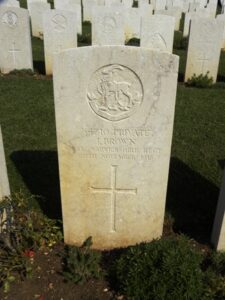
George Henry Harris Brownhill, Private, 18694, Duke of Edinburgh’s Wiltshire Regiment. George was the son of George Henry and Maria Brownhill, of 8, Brick House, Pill, Milford Haven. He enlisted at Milford into the Welsh Regiment, but was then posted to the 5th Battalion, Wiltshire Regiment, which formed part of 40 Brigade, 13th (Western) Division. The Division had fought at Gallipoli, and remained there until being evacuated in January 1915, from where it moved to Egypt, where it was posted to the Suez Canal defences. In 1916 the Division moved to Mesopotamia, and took part in a long and terrible struggle against the Turks for the remainder of the war. George died here on 28 August 1918, aged 23, and is buried at Baghdad (North Gate) War Cemetery.
James Walter Buck, Deck Hand, DA/15469, Royal Naval Reserve. James was born at Caister, Norfolk on 22 February 1878, the son of George Walter Buck and Mary Buck. He resided with his wife Gladys Ethel Buck, at 10, Warwick Road, Milford Haven. James was serving aboard HM Drifter Petrel. James died after the war, on 10 March 1919, aged 38, and is buried at Milford Haven Cemetery.
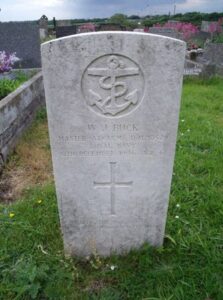
John Charles Burr, Private, 54031, Welsh Regiment. John was born in Hull in 1885, the son of John and Annie Burr. By 1901 the family was residing at 30, Dartmouth Street, Milford Haven, where John’s father ran his own business as a Fish Merchant. John enlisted into the Army at Milford, and was posted to the 14th Battalion, Welsh Regiment as a reinforcement. The battalion was known as the Swansea Pals battalion, and was in France as part of 114 Brigade, 38th (Welsh) Division. John would have joined the battalion after the fighting at Mametz Wood, and moved with the battalion to new positions north of Ypres, near Boesinghe, in August 1916. Here the Welsh Division took over the line running along the Canal Bank, and were to remain here for the coming twelve months leading up to the Battle of Passchendaele. John though was killed in action while the Swansea Pals were in the line on 1 November 1916, aged 31. He was buried at Essex Farm Cemetery, Belgium.
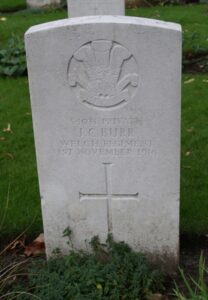
Walter Henry Byard, Deck Hand, 2909DA, Royal Naval Reserve. Walter was born at Gloucester on 27 June 1884. During the war he lived with his wife Alice Byard, at Priory Village, Milford Haven. Walter served as Deck Hand aboard HM Trawler Lobelia II, and was killed when she struck a mine and sank off Lough Swilly on 19 April 1917. Walter was 32 years old, and is commemorated on the Plymouth Naval Memorial, Devon.
John Herbert Byford, Leading Stoker, K/19069, Royal Navy. John was born at Sheffield on 22 December 1889. He was a long serving Royal Naval rating, and resided at Milford prior to the war, with his wife Alice M. Byford (nee Paton), of Beach Road, Pill, Milford Haven. John served aboard the pre-dreadnought Battleship HMS Goliath. Goliath had been built for service in the Pacific, and was obsolete by the outbreak of the Great War. Nevertheless, her powerful firepower made her of use to the ground forces which were landed on Gallipoli from 25 April 1915 onwards, and Goliath spent the last few months of her life in action here, before being sunk by the Turkish torpedo boat Muavanet on 13 May 1915. John was drowned when Goliath sunk that day. He was 26 years old, and is commemorated on the Chatham Naval Memorial, Kent.
David John Carpenter, Deck Hand, 2766DA, Royal Naval Reserve. David was born on 2 March 1899, the son of Henry and Mary Carpenter, of 5, Hill Street, Hakin. He enlisted at Milford in August 1914 into the 9th Battalion, Welsh Regiment, but within months had been found to be under-age and discharged for misconduct, having lied on his attestation form. David then enlisted into the Royal Naval Reserve, and served as Deck Hand aboard the ‘Q-Ship’ HMS Prize. He was killed when Prize was sunk during an action against the German submarine U-48 in the Atlantic on 15 August 1917. He was just 18 years old, and is commemorated on the Plymouth Naval Memorial, Devon.
Percy Edmund Carpenter, Gunner, 79298, Royal Garrison Artillery. Percy was the son of Mr. and Mrs. Carpenter, of Great Yarmouth. He married Henrietta Louise Spencer on 5 November 1900, and the couple resided at 5, The Grove, Chapel Field, Norwich. Percy enlisted into the Royal Garrison Artillery on 3 May 1916, and spent the following six months on home service, probably at Milford. Percy was posted to France on 13 August 1916, and joined the 6th Siege Battery, Royal Garrison Artillery. Percy probably served on the Somme in 1916, and was killed during the Battle of Messines on 20 June 1917, aged 36. Percy is buried at La Plus Douve Farm Cemetery, Belgium. His ties to Milford are unknown.
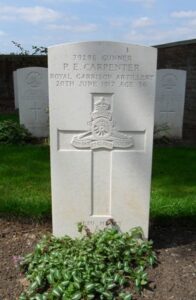
Thomas Wilfred Chope, Chief Petty Officer, 172371, Royal Navy. Thomas was born at Portsmouth on 4 October 1877, the son of Thomas and Mary Ann Chope. Mary was from Milford Haven. Thomas married Daisy Beatrice Calloway, of 53, Whitecliffe Avenue, Copnor, Portsmouth prior to the war. He served as Chief Petty Officer aboard HMS Bulwark, which was a pre-dreadnaught Battleship of the Formidable Class. On the morning of 26 November 1914, Bulwark was anchored safely in the estuary at Medway, when a terrific explosion ripped her apart, and she sank with the loss of 740 lives. A Naval Court of Enquiry found that the explosion was probably caused by an overheating cordite charge, stored near one of the boiler room bulkheads. Thomas was 37 years old when he died that day, and is commemorated on the Portsmouth Naval Memorial, Hampshire.
Charles Clarke, Second Hand, 206SA, Royal Naval Reserve. Charles was born on 16 March 1893, the son of John Thomas Clarke and Elizabeth Clarke, of 20, Dartmouth Street, Milford. He served as Second Hand aboard H.M. Trawler Corientes. Corientes had been requisitioned by the Admiralty in 1915, and was fitted with a 6-pounder gun before entering service as a minesweeper. On 23 June 1917, she was patrolling off Malin Head, Ireland, when she struck a mine, and sank with all hands. Charles was one of the men lost aboard her, and he is commemorated on the Plymouth Naval Memorial, Devon. His widow, Lizzie Ann Clarke, was residing at McKinley (Grocer), Main Street, Buncrana, Ireland.
Edwin Mark Clarke, Deck Hand, SD/82, Royal Naval Reserve. Edwin was born on 5 May 1896, the son of Ethel Clarke, of 81, Goldstone Villas, Hove, Sussex. He resided at Milford prior to the war, with his wife Gladys Gertrude Clarke, at 35 Starbuck Street, Milford Haven. Edwin served aboard HMS Q22, which was another of the Q-Ships to sail from Milford during the war. He died aboard Q22 when she was attacked and shelled by the German Submarine UC-47 on 22 April 1917. Edwin was brought back to Milford, and was buried with full military honours at Milford Haven Cemetery.
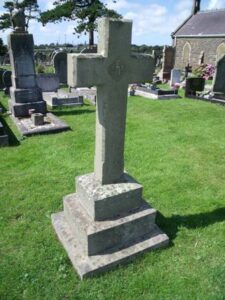
Frederick William Clarke, Sapper, 47409, Royal Engineers. Frederick was the son of James and Elizabeth Clarke, of 2, Robert Street, Milford Haven. He was one of three brothers who enlisted at Milford on 4 September 1914 into the Royal Engineers. Frederick and his brother Benjamin were posted to the 98th Field Company, which was attached to the 21st Division. Frederick embarked for France on 10 September 1915, and moved with the division to Loos, where it was sent into action on 26 September, suffering over 3,800 casualties for very little gain. The division moved to the Somme in 1916, and fought at the Battle of Albert and at the Battle of Bazentin. This is where Frederick was killed in action on 14 July 1916, with his brother Benjamin by his side. Frederick was 26 years old, and is commemorated on the Thiepval Memorial, France.
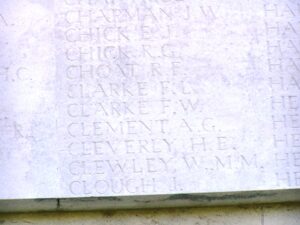
Howard Cleevely, Private, 14388, Welsh Regiment. Howard was the son of Frank and Clara Cleevely, of Milford Haven. He had enlisted at Milford into the Army, and joined the 9th Battalion, Welsh Regiment, which was attached to 58 Brigade, 19th (Western) Division. The Division assembled around Bulford during September 1914. Divisional training was completed near Tidworth, from March 1915, and the ‘Butterfly Division’ crossed to France between 11 and 21 July 1915, and moved to positions near Loos. The Division fought during the opening attack of the Battle of Loos, and then moved to the Somme, where they took part in the second wave of the attack on Ovillers-La Boiselle on 1 July, capturing the village at heavy cost, and fought through the Somme Battles of Pozieres and the Ancre in 1916. Howard was wounded at the Ancre, and evacuated to a Casualty Clearing Station for treatment, but sadly died of his wounds on 6 November 1916. He was 24 years old, and is buried at Warloy-Baillon Communal Cemetery Extension, France.
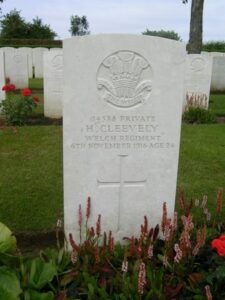
E. Cole, Royal Naval Reserve. Cannot presently be identified.
E. Cole, Royal Naval Reserve. Cannot presently be identified.
Albert George Coles, First Engineer, Mercantile Marine. Albert was born at Cardiff in 1879. He worked at Milford for several years prior to the war, and in 1904 married Agnes Maud Elliot, of 16, Trafalgar Road, Milford. Albert served aboard the Steam Trawler Victoria, which had been registered at Fleetwood. On 1 June 1915 Fleetwood was fishing in the Irish Sea when a German U-Boat, U-34, surfaced. Fleetwood tried to steam away, but the U-Boat began shelling it with its deck-gun. Albert and Stevo Stephenson were killed at the bridge when a shell struck the trawler. The surviving crew attempted to surrender, but the Germans sunk the trawler, killing a further three men. Albert was 36 years old when he died that day, and is commemorated on the Tower Hill Memorial, London. Albert is not commemorated on the memorial, although he could be the man named E. Cole, above, who is named twice?
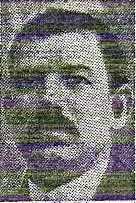
Samuel Bradfield Cozens, Private, 145969, Machine Gun Corps. Samuel was born at Pembroke on 1 May 1899, the son of Thomas Charles Cozens and Eveline Cozens (nee White). The family later resided at the Post Office, Cosheston, Pembroke. Samuel was called up into the army late in 1917, and after training was posted to the 17th Battalion, Machine Gun Corps, attached to the 17th (Northern) Division. In March, 1918 the Division were on the Somme, and faced the German Spring Offensive there, fighting at the Battle of St Quentin, and retreated back, fighting at the First Battle of Bapaume. After a period out of the line to rest and rebuild, the Division moved to the southernmost sector of the Somme area, where they fought at the Battle of Amiens on 8 August 1918, a day which saw the war swing in the favour of the Allies. The Allies then advanced on the Somme, and the Division fought at the Battle of Albert later that month, which marked the beginning of the advance to victory. Samuel was killed during the first week of the great advance, on 28 August 1918. He was 20 years old, and is commemorated on the Vis-En-Artois Memorial, France. His brother, Hubert White Cozens, was awarded the Military Medal during the war. The photograph of Samuel is courtesy of Joy Cozens, his niece. Samuel is also commemorated on the Cosheston Memorial.
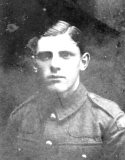
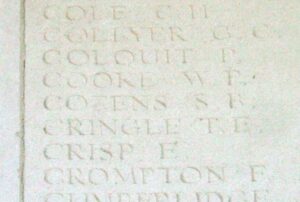
William Charles Crisp, Second Hand, 434DA, Royal Naval Reserve. William was born on 28 April 1885, the son of Samuel and Emma Crisp, of Halesworth, Suffolk. Prior to the war he was residing with his wife Fanny Winifred Crisp (nee Bevans), of 5, Prioryville, Milford Haven. He served aboard HM Trawler Lydian, and was killed when she was sunk by a mine explosion off South Foreland on 18 September 1915. William was 29 years old, and is commemorated on the Plymouth Naval Memorial, Devon.
Joseph Curtis, Rifleman, 2524, Liverpool Regiment. Very little is known of Joseph, but he originally served with the 3/5th Battalion, King’s Liverpool Regiment on home service. He was later transferred to the 430th Company, Labour Corps. Joseph survived the war, but sadly died as a result of his war service on 3 January 1921, aged 50. He is buried at Bath (Locksbrook) Cemetery, England.
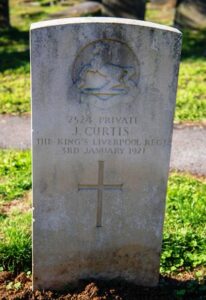
Albert Davies, Trimmer, 6189TS, Royal Naval Reserve. Albert was born on 19 October 1876, the son of William and Mary Davies, of Hakin. He lived with his wife Esther Davies, at Lower Thornton, Milford Haven. Albert served aboard HM Trawler Evangel, and was killed when Evangel was sunk by a mine explosion in the English Channel on 25 March 1917. Albert was 39 years old, and is commemorated on the Plymouth Naval Memorial, Devon.
Edward James Davies, Private, 38356, Welsh Regiment. Edward was the son of George and Caroline Davies, of Hubberston. He enlisted at Milford into the Army, joining the 8th Battalion, Welsh Regiment. The battalion formed part of 40 Brigade, 13th (Western) Division, and between 6 and 16 July 1915 landed on Cape Helles and relieved the 29th Division. They left and returned to Mudros at the end of the month, and the entire Division landed at ANZAC Cove between 3 and 5 August, 1915, taking part in the Battles of Sari Bair, Russell’s Top, and Hill 60, ANZAC. Soon afterwards the Division was transferred from ANZAC to Suvla Bay, and it was evacuated from Suvla on 19 December 1915, whereupon the infantry moved after a week’s rest to the Helles bridgehead, where they faced the last Turkish attacks at Helles. On 8 January 1916, the Division was evacuated from Helles, and by 31 January was concentrated at Port Said, where they held forward posts in the Suez Canal defences. On 12 February, 1916 the Division began to move to Mesopotamia, to strengthen the force being assembled for the relief of the besieged garrison at Kut al Amara. Edward was killed during the opening of the move into Mesopotamia on 9 February 1917, aged 19. He is buried at Amara War Cemetery, Mesopotamia.
Frederick Davies, Private, 39740, Royal Welsh Fusiliers. Frederick was the son of George Lorne and Mary Davies, of 9, St. Peter’s Road, Milford Haven. He was a fireman with the GWR prior to the war, and enlisted at Milford into the Royal Welsh Fusiliers on 24 January 1916. On 9 July 1916 Frederick landed in France and was posted to the 2nd Battalion, Royal Welsh Fusiliers, which had been in France since the outbreak of war. By the time that Frederick joined the battalion, they had fought throughout the Battle of Loos and the opening of the Somme Battles, and had become attached to 19 Brigade, 33rd Division. Frederick then fought with the battalion at the Battle of the Menin Road and at Polygon Wood, during Third Ypres, and this is where he was killed on 30 November 1917, aged 22. He has no known grave, and is commemorated on the Tyne Cot Memorial, Belgium.
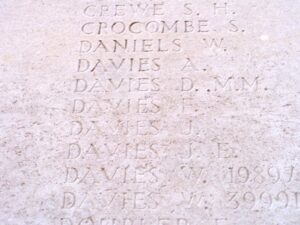
Thomas Davies, Private, 52888, Welsh Regiment. Thomas was born at Steynton in 1894, the son of John and Elizabeth Davies. He married prior to embarking for war, and his wife E. M. Davies resided at Primrose Cottage, Woodson, Milford Haven. Thomas enlisted at Cardiff into the army, joining the 11th Battalion, Welsh Regiment, which was known as the Cardiff Pals battalion, attached to 67 Brigade, 22nd Division. The Division crossed to France in early September 1915, with all units being concentrated near Flesselles by 9 September, but on 27 October 1915 the Division, embarked for Salonika from Marseilles. It completed concentration there in November, and took part in the Retreat from Serbia during December 1915. During August 1916 the division fought at the battle of Horseshoe Hill, and the following month fought at the battle of Machukovo. During the end of April and 9 May 1917 the Division fought at the battle of Doiran. Thomas took ill and died in Salonika on 13 September 1917, aged 23. He is buried at Kirechkoi-Hortakoi Military Cemetery, Salonika.
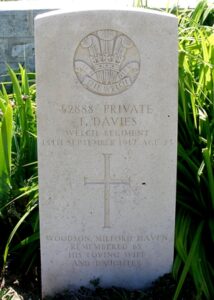
Thomas George Davies, Engineman, 1620/ES, Royal Naval Reserve. Thomas was born on 28 March 1876, the son of Benjamin and Eleanor Davies, of Hazelbeach, Neyland, and the husband of Alice Maud Davies, at 7, Bellevue Terrace, Neyland. He served aboard HM Trawler Othonna as an Engineman. The Othonna was sunk when she struck a mine off Fife Ness on 20 April 1917 which had been laid by UC41 just a day earlier. The trawler sank with the loss of all hands. Some of the men’s bodies were washed ashore, and so afforded burial, one of whom was Thomas, who was 40 years old, and is buried at Honeyborough Cemetery, Neyland.
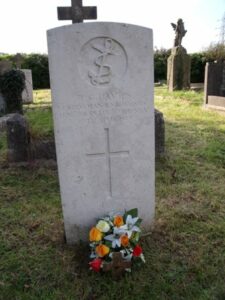
William John Davies, Sergeant, D/20358, Cavalry. William was the husband of Mary Ellen Davies, of 57, Shakespeare Avenue, Milford Haven. He had worked as a prison warder at HM Prison, Preston and at HM Prison Dartmoor prior to the war. William had originally served with the 6th (Inniskilling) Dragoons during the war, before being transferred to the 6th Reserve Cavalry Regiment, possibly as a result of wounding. The 6th Dragoons had served on the Western front for the duration of the war. William died of liver disease on 12 March 1919 at the age of 37. He is buried at Chiseldon Cemetery, England.
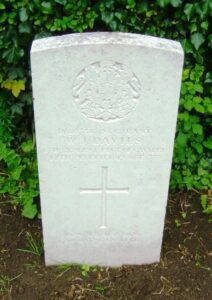
William Davies, Gunner, 447, Royal Garrison Artillery. William was the son of William and Ellen Davies, of Upper Road, Thornton, Milford Haven. He had enlisted at Milford into the Royal Garrison Artillery, joining their newly formed 68th Siege Battery, based at Hubberston, and moved to France with the battery in 1916. Williams’ time in France was to be short however, as he was killed at Arras on 25 May 1916. William was 22 years old, and is buried at Fauborg D’Amiens Cemetery, Arras, France.
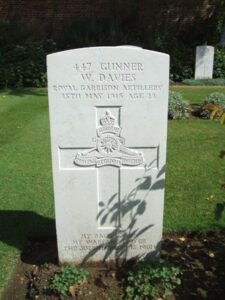
Hubert Francis Day, Second Lieutenant, Royal Fusiliers. Hubert was the son of John Henry and Margaret Day, of 128, Robert Street, Milford Haven. He was commissioned into the Honorable Artillery Company, before joining the 11th Battalion, Royal Fusiliers, which formed part of 54 Brigade, 18th (Eastern) Division. On 25 May 1915 the Division landed in Boulogne, and didn’t see its first major action until July, 1916 when it took part in the Battle of Albert. They then fought at the Battle of Bazentin, where they captured Trones Wood, and moved on to the Battle of Delville Wood. In October they took part in the Battle of the Ancre Heights, and captured Schwaben Redoubt, and helped capture Regina Trench. They then fought at the Battle of the Ancre, and during the subsequent Operations on the Ancre, before spending the winter on the Somme. In March, 1917 they followed the German Retreat to the Hindenburg Line, and in May took part in the Third Battle of the Scarpe, which was part of the Arras Offensive. July, 1917 saw the Division at Ypres, where they took part in the Battle of Pilckem, where they helped capture Westhoek, and then they fought at the Battle of Langemarck. Hubert was killed here on 10 August 1917. He was 22 years old, and is commemorated on the Ypres (Menin Gate) Memorial, Belgium. His brother John Henry was also killed.
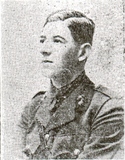
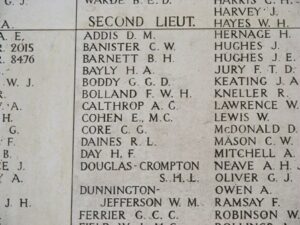
Walter Dayes, Lance Corporal, 18184, Canadian Infantry. Walter was born on 12 July 1893, the son of Walter and Winsor Dayes, of 22, Dewsland Street, Milford Haven. He had emigrated to Canada prior to the war, and worked there as a miner. Walter was one of the first to enlist in Canada, sensing the call of the British Government to its Imperial Allies, he enlisted at Valcartier on 18 August 1914, joining the 1st Battalion (Western Ontario), Canadian Infantry, which was attached to the 1st Canadian Brigade, 1st Canadian Division. The Division arrived in England in October 1914, and after training at Salisbury Plain, embarked for France in February 1915. The Division moved to the Ypres Salient in April, and faced its first real test during the defence of St. Julien beginning on 22 April, where the Canadians withstood German attacks, aided, for the first time, by the use of poison gas, and finally retired to secondary positions on 26 April, where they held on until 4 May. Two weeks later, the division was in action again at Festubert, aiding in a diversionary offensive by the British armies, and the Canadians suffered 2,200 casualties for gains of only 600 yards. Another futile attack was launched at Givenchy in June 1915, after which the division moved to Ploegsteert. Walter was killed in action at Givenchy on 15 June 1915, aged 22. He has no known grave, and is commemorated on the Vimy Memorial, France.
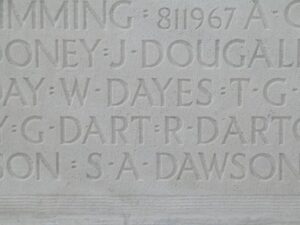
George Samuel Dunn, DSM, Chief Engineman, 92ES, Royal Naval Reserve. George was born at Bristol on 16 October 1882. He married Caroline Stewart, of 12, Brooke Avenue, Milford Haven, in 1904. George served aboard HM Drifter Silvery Harvest. George had been awarded the Distinguished Service Medal, the notification of which appeared in the London Gazette of 5 April 1918. Sadly, George was drowned soon after, when Silvery Harvest was lost in a collision off Berry Head on 16 May 1918. He was 35 years old, and is commemorated on the Plymouth Naval Memorial, Devon.
Harry Dyer, Seaman, 3945B, Royal Naval Reserve. Harry was born on 7 August 1883, the son of William and Sarah Dyer, of Brixham, Devon. He married in 1907, and prior to the war lived with his wife Mina Dyer, at 61, Waterloo Road, Hakin. Harry served aboard HMS Laurentic, which was an ocean liner, belonging to the White Star Line. Laurentic was used for transatlantic travel between Liverpool and Canada, and being in Canada at the outbreak of war, was requisitioned for the transport of Canadian Troops to Britain. In 1915 she was converted to an armed transport ship, and sunk when she struck a mine off Lough Swilly on 25 January 1917. Over 350 of her crew were lost, one of whom was Harry Dyer. He was 32 years old, and is commemorated on the Plymouth Naval Memorial, Devon.
John Evans Edwards, Private, 278199, Royal Air Force. John was the son of Benjamin and Mary Edwards of Milford, and the husband of Gertrude E. Edwards, of 88, Portfield, Haverfordwest. He had been conscripted into the Royal Air Force, and was based at the Armament School at Uxbridge when he died of influenza on 22 October 1918. John was 35 years old, and is buried at Milford Haven Cemetery.
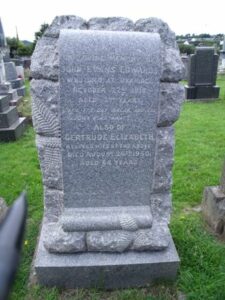
William George Edwards, Sapper, 15442, Royal Engineers. William was the son of Thomas and Hannah Edwards, of Court House, Hubberston. He worked at HM Dockyard prior to the war, and enlisted at Pennar into the Royal Engineers. After receiving his training, he was posted to the 11th Field Company, Royal Engineers, which was attached to the 2nd Division. One of the first Divisions to move to France, the 2nd Division remained on the Western Front throughout the war. They moved to Belgium, where they fought at the Battle of Mons, and retreating southwards, fought at the Affair of Landrecies, the Rearguard Actions of Villers-Cotterets, and at the Battle of the Marne where the German offensive was stopped. The Germans retreated north, and the BEF met them, fighting at the Battle of the Aisne. The 2nd Division were then moved to Flanders, where they fought at the First Battle of Ypres, when the German sweep through Flanders was stopped, and remained there throughout the first winter of the war. William died in Flanders on 11 January 1915, aged 28. He is buried at Le Touret Military Cemetery, Richebourg-L’Avoue, France.
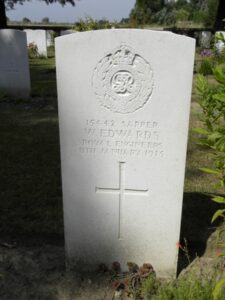
Charles Edwin Evans, Private, 37728, Welsh Regiment. Charles was the son of Edwin and Hannah Evans, of 51, Priory Road, Milford Haven. He enlisted at Haverfordwest into the 9th Battalion, Welsh Regiment, which was attached to 58 Brigade, 19th (Western) Division. The Division crossed to France between 11 and 21 July 1915, and moved to positions near Loos, where it took part in the opening attack of the Battle of Loos on 25 September 1915. The 9th Welsh attacked positions on the northern edge of the Loos battlefield, but suffered terrible casualties. Charles was one of the many men killed on the opening day of the Battle, on 25 September 1915, aged 19. Charles has no known grave, and is commemorated on the Loos Memorial, France.
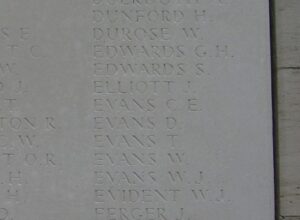
Leslie Evans, Gunner, 371230, Royal Garrison Artillery. Leslie was the Brother of Nellie Warr, of 2, Hill Street, Hakin. He was another local man to enlist into the Royal Garrison Artillery, and was posted to its 68th Brigade. Little else is known of Leslie, but he died of wounds in France on 3 May 1917, aged 26, and is buried at Wimereux Communal Cemetery, France.
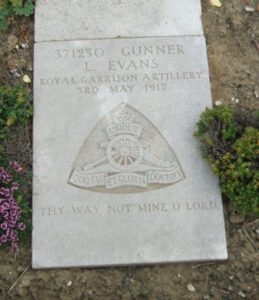
Thomas Davies Evans, Serjeant, 91534, Royal Engineers. Thomas was born at Lampeter, but resided at Milford prior to the war. He enlisted at Bridgend into the army, and was posted to the 151st Field Company, Royal Engineers, which was formed at the end of 1914 as part of the 38th (Welsh) Division. The division crossed to France in December 1915, and took the line near Fleurbaix, where it remained until June 1916, when it began the long trek south to the Somme. In July 1916 the Division fought at Mametz Wood, suffering heavy casualties in the capture of the wood, before being moved to the Boesinghe sector, north of Ypres. They remained here for the coming year, and fought at the Battle of Pilckem Ridge on 31 July 1917, and also during the resulting Battle of Langemarck. Thomas was killed around this time, on 4 September 1917, aged 42. He is buried at Bard Cottage Cemetery, Belgium.
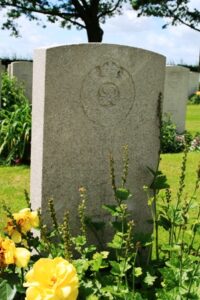
James Ferguson, Deck Hand, 1482SD, Royal Naval Reserve. James was born at Edinburgh on 16 March 1896. He was based at Milford during the war, and was the husband of Diana J. Ferguson, of 4, Charles Street, Milford Haven. James served as Deck Hand aboard HMS Prize, and was killed when Prize was sunk in action with the German Submarine U-48 on 14 August 1917, aged 21. He is commemorated on the Portsmouth Naval Memorial, Hampshire.
Richard Flynn, Private, 37701, Welsh Regiment. Richard was the youngest Milford soldier to be killed during the war. He was the son of Richard and Alice Flynn, of 37, Priory Road, Milford Haven. Richard enlisted at Milford into the Army, and joined the 9th Battalion, Welsh Regiment, which was attached to 58 Brigade, 19th (Western) Division. The Division assembled around Bulford during September 1914. Divisional training was completed near Tidworth, from March 1915, and the ‘Butterfly Division’ crossed to France between 11 and 21 July 1915, and moved to positions near Loos. The Division fought during the opening attack of the Battle of Loos, and it was during the initial assault that Richard was killed, on 25 September 1915. He was just 15 years old, and is commemorated on the Loos Memorial, France.
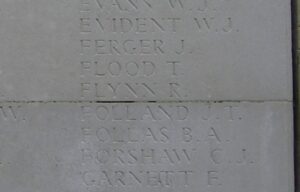
Henry Watkins Foster, Private, DM/2/129945, Army Service Corps. Henry was born on 15 July 1873, the son of Henry Simmonds Foster and Caroline Foster, of Kings Cross, London. He had married prior to the war, and lived with his wife, Gertrude Foster, at Temperance Hall, Charles Street, Milford Haven where he worked as a fisherman and was a member of the Royal Naval Reserve. Henry enlisted at Milford into the Army, and was posted to the Army Service Corps, and was posted to East Africa with his unit, where the British colonial troops were fighting against German troops in German East Africa. The campaign proved fruitless for the British until the Armistice was declared. The Germans fought a guerrilla war, using a small number of troops to keep a numerically superior British and Empire force tied down for the full four years of the war, only surrendering after the Armistice of 1918. Henry died of sickness in East Africa on 23 October 1916. He was 43 years old, and was buried at Taveta Military Cemetery, Kenya.
Charles Wilfred Galvin, Private, 24111, Royal Fusiliers. Charles was born at Milford Haven in 1895, the son of Edith Galvin, of 79, Campbell Street, Steynton. By the time of the outbreak of war he lived at Twickenham, where he enlisted into the 7th Battalion, Royal Fusiliers. The battalion landed at Le Havre on 24 July 1916 where it was attached to 190 Brigade, 63rd (Royal Naval) Division. The Division moved to positions on the Somme, where it took part in the Battle of the Ancre, and the resulting Operations on the Ancre. In April 1917 the Division were at Arras, and fought at the Second Battle of the Scarpe, where they captured Gavrelle. They then fought at the Battle of Arleux, before moving north to Ypres, where they took part in the Second Battle of Passchendaele. Their next major action was at Cambrai, during the Action of Welch Ridge, and they were still in the area when the Germans launched their Spring Offensive, and fought at the Battle of St Quentin, and then the First Battle of Bapaume. In August, the Division took part in the Battle of Albert, which marked the beginning of the great offensive which was to end the war. Charles was killed during this time, on 27 August 1918, aged 22. He is buried at A.I.F. Burial Ground, Flers, France.
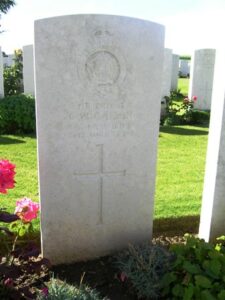
Charles Arthur Garnish, Skipper, Royal Naval Reserve. Charles was the son of Henry and Lucy Garnish, of Brentwood. He married Margaret Jane Davies whilst working at Milford in 1891, and the couple raised eight children at 71, Robert Street, Milford. Charles served as Skipper aboard HM Trawler Kirkland, and was drowned when she was mined and sank on 20 August 1917 off Fugla Skerry, Papastour, Shetlands. Charles was 47 years old, and is commemorated on the Plymouth Naval Memorial, Devon.
Frederick John Gibson, Sergeant, 200030, Welsh Regiment. Frederick was the son of John and Madeline Gibson, of Milford Haven. He enlisted at Milford into the 1/4th Battalion, Welsh Regiment, part of 159 Brigade, 53rd (Welsh) Division. Fred served with the battalion during its time at Gallipoli, and was with them during the evacuation, moving to Egypt. At the beginning of 1917 the British launched an offensive into Palestine, and the 4th Welsh fought at the First Battle of Gaza, which is where Fred was killed on 27 March 1917, aged 25. He is commemorated on the Jerusalem Memorial, Egypt.
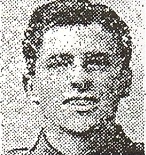
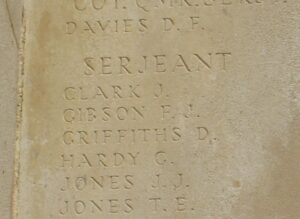
Alfred Phelps Hancock, Private, 16226, Welsh Regiment. Alfred was the son of Frederick and Elizabeth Hancock, of 37, Point Street, Hakin. He enlisted at Milford into the Army, and joined the 9th Battalion, Welsh Regiment, which was attached to 58 Brigade, 19th (Western) Division. The Division assembled around Bulford during September 1914. Divisional training was completed near Tidworth, from March 1915, and the ‘Butterfly Division’ crossed to France between 11 and 21 July 1915, and moved to positions near Loos. The Division fought during the opening attack of the Battle of Loos, and then moved to the Somme, where they took part in the second wave of the attack on Ovillers-La Boiselle on 1 July, capturing the village at heavy cost, and fought through the Somme Battles of Pozieres and the Ancre in 1916. They then moved North to Ypres, taking part in the Battle of Messines, and this is where Alfred was killed on 7 June 1917. He was 23 years old, and is commemorated on the Ypres (Menin Gate) Memorial, Belgium.
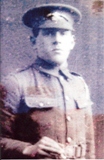
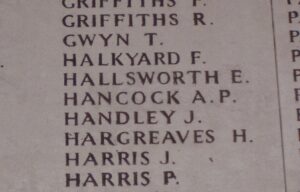
Ernest James Harding, Deck Hand, 2958TS, Royal Naval Reserve. Ernest was born on 19 January 1897, the son of Ernest and Catherine Harding, of 12, Marble Hall, Milford Haven. He served as Deck Hand aboard HM Trawler Evangel, and was drowned when she was lost following a mine explosion in the English Channel on 25 March 1917, aged 20. Ernest is commemorated on the Plymouth Naval Memorial, Devon.
David Owen Harris, Engineman, 1408ES, Royal Navy. David was born on 9 July 1878, the son of John and Magdalen Harris of Carmarthen. He had enlisted into the Royal Navy at a young age, and by 1911 was living with his wife Florence E. Harris, at 53, Waterloo Road, Hakin. David served aboard HM Trawler Blackthorne, which was a hired net drifter. David was accidentally drowned on 21 February 1918. He was 39 years old, and is commemorated on the Plymouth Naval Memorial, Devon.
Thomas Harries, Deck Hand, 9630DA, Royal Naval Reserve. Thomas was born on 22 January 1878, the son of William and Helen Harries, and the husband of Annie Harries, of Hakin Villa, 4, Wellington Avenue, Milford Haven. He served as Deck Hand aboard HM Trawler Loch Shiel. Thomas was killed when Loch Shiel struck a mine off Milford on 26 September 1916. He was 39 years old, and is commemorated on the Plymouth Naval Memorial, Devon.
William Henry Cornish Harris, Second Hand, SA/2441, Royal Naval Reserve. William was born on 21 November 1894, the son of William Henry Harris and Emma Harris, of 22, Warwick Road, Milford Haven. William had been brought up working on the trawlers, and had joined the Royal Naval Reserve at the outbreak of war. He served aboard H.M.S. Sabrina, a Medina Class Gunboat. He had been ill for a while before dying of sickness whilst on active service, on 8 August 1916, aged 21, and was buried with full military honours at Milford Haven Cemetery.
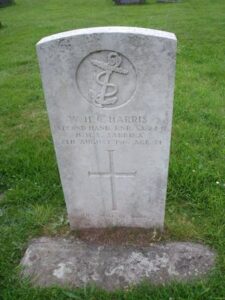
John Harvey, Engineman, ES/99, Royal Naval Reserve. John was born at Aberdeen on 10 November 1882, and was the husband of Catherine Harvey, of 10, Pill Road, Milford Haven. He served aboard HM Trawler Falmouth III, which was used for minesweeping duties around Dover Docks, and was killed when she sunk after striking a mine laid the previous morning by German submarine UC-5, on 19 November 1915. John was 41 years old, and is buried at Milford Haven Cemetery.
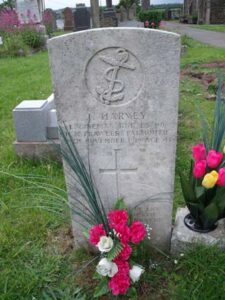
William Ronald Hastings, Private, 78599, Welsh Regiment. William was the son of Robert and Annie Hastings, of 13, Chapel Street, Milford Haven. William worked as a Butcher’s Assistant prior to enlisting into the Welsh Regiment on 24 June 1918, and was posted to the 52nd Training Reserve Battalion at Kinmel Park. Within months he became ill, and was invalided to Norfolk War Hospital in Norwich where he was found to be suffering from tuberculosis, and he was discharged from the army as medically unfit on 7 November 1918. William died of tuberculosis at Hubberston on 16 March 1919, aged just 18, and is buried in Milford Haven Cemetery. William’s case was passed onto the CWGC on 5 August 2012. He was initially rejected through lack of evidence on 21 July 2014, but has today, Tuesday 22 October 1914 been accepted for commemoration after further evidence was uncovered. He is presently commemorated in the United Kingdom Book of Remembrance, pending confirmation of his burial at Milford, and the CWGC have recently erected a new headstone to mark his grave.
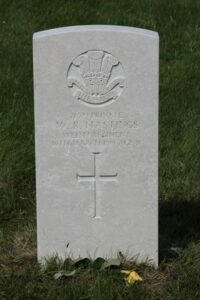
Theophilus Henry Hicks, Corporal, 30959, Welsh Regiment. Theo was the son of Thomas and Louisa Hicks, of Church Road, Hubberston, Milford Haven. He enlisted at Haverfordwest into the 1st Battalion, Welsh Regiment. The battalion was in India at the outbreak of war, and were quickly recalled to Britain, where it joined 84 Brigade, 28th Division. The Division formed in England between December 1914 and January 1915 from regular units returning from India, Singapore and Egypt. During January 1915 it moved to France, landing at Le Havre and moved to the Western Front, where it saw its first major action during the Second Battle of Ypres. Following serious casualties at Ypres, a Composite Brigade was formed, composing of the 2nd Battalion, the Buffs, 2nd Battalion, the Cheshire’s, 1st Battalion, the Welsh, and 1st Battalion, the York and Lancaster. It was dissolved on 19 May 1915, and the formation assumed its normal configuration, taking part in the Battle of Loos. During October 1915, the Division embarked at Marseilles, and proceeded to Egypt, and in November moved on to Salonika where the Division then remained. Theo died at No 4 Hospital, Versailles on 11 October 1915, aged 25. He is buried at Les Gonards Cemetery, Versailles, France.
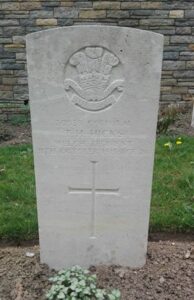
Robert Stanley Higgs, Private, 30805, Welsh Regiment. Stanley was the son of William and Maud Higgs, of Milford Haven, and the husband of Christina Higgs, of High Road, Whetstone, London. He had served during the Boer War with the 1st Volunteer Company, Welsh Regiment. At the outbreak of the Great War Stanley enlisted at Haverfordwest into the 1st Battalion, Welsh Regiment, which had been recalled to Britain from India, and joined the 84 Brigade, 28th Division. The Division formed in England between December 1914 and January 1915 from regular units returning from India, Singapore and Egypt. During January 1915 it moved to France, landing at Le Havre and moved to the Western Front, where it saw its first major action during the Second Battle of Ypres. Stanley was wounded at Ypres, and died of wounds on 21 April 1915, aged 38. He is buried at Bedford House Cemetery, Belgium. Stanley is also commemorated on the Haverfordwest War Memorial.
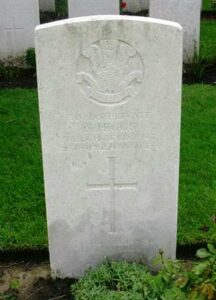
Harry Hoad, Private, 14332, Welsh Regiment. Harry was the son of Samuel and Sarah Hoad, of 124, Robert Street, Milford Haven. He enlisted at Milford into the 9th Welsh, and served in France from September 1915. Harry must have been wounded at some time, and transferred to the Middle East to join the 24th Battalion (Pembroke & Glamorgan Yeomanry), Welsh Regiment, which had been formed in Egypt in 1917 as part of 231 Brigade, 74th (Yeomanry) Division. In the spring of 1917 the Division begun their advance into Palestine, and Harry fought with the battalion at the Second Battle of Gaza. He was killed during the Third Battle of Gaza, on 6 November 1917, aged 30. Harry is buried at Beersheba War Cemetery, Israel.
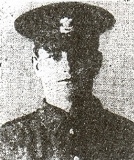
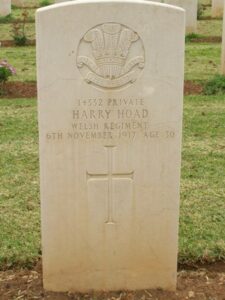
Stratton Leonard Hodgkinson, Private, 48828, South Wales Borderers. Leonard was the son of Mrs. Mary Annie Hitchings (formerly Hodgkinson), of 195, Robert Street, Milford Haven. He enlisted at Porth into the 8th Welsh. He then transferred into the 1st Battalion, South Wales Borderers at some time, which was in France as part of 3 Brigade, 1st Division. Leonard was killed in action during the final phase of the war, during the drive towards the Hindenburg Line on 1 October 1918. He is buried at Savy British Cemetery, France. His brother Thomas also fell.
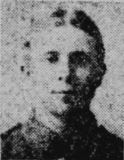
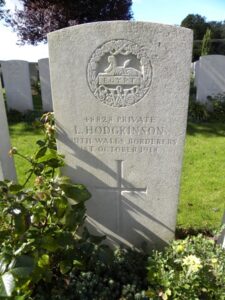
Thomas William Hodgkinson, Private, 1830, Welsh Regiment. Thomas was the son of Mrs. Mary Annie Hitchings (formerly Hodgkinson), of 195, Robert Street, Milford Haven. He had enlisted at Pontypridd into the 8th Battalion, Welsh Regiment, which was attached to 40 Brigade, 13th (Western) Division. The Division fought at Gallipoli, and was evacuated from Suvla on 19 December 1915, whereupon the infantry moved after a week’s rest to the Helles bridgehead, where they faced the last Turkish attacks at Helles. On 8 January 1916, the Division was evacuated from Helles, and by 31 January was concentrated at Port Said, where they held forward posts in the Suez Canal defences. On 12 February, 1916 the Division began to move to Mesopotamia, to strengthen the force being assembled for the relief of the besieged garrison at Kut al Amara. By 27 March, the Division had assembled near Sheikh Saad and came under orders of the Tigris Corps, and then took part in the attempts to relieve Kut. However, after these efforts failed and Kut fell, the British force in the theatre was built up and reorganised. The Division then fought at the Battle of Kut al Amara, then at the capture of the Hai Salient and the capture of Dahra Bend. They took part in the passage of the Diyala, in the pursuit of the enemy towards Baghdad, and it was around this time that Thomas was wounded. He died of his wounds on 12 January 1917, aged 22, and is buried at Amara War Cemetery, Iraq. His brother Leonard also fell.
Edward Hoggins, Private, 7180, Kings Shropshire Light Infantry. Edward was born in Staffordshire in 1885, the son of John and Jane Hoggins. He was a regular soldier, and resided with his wife Rachel Ellen Hoggins, at 4, Castle Terrace, Milford Haven. Edward served with the 1st Battalion, King’s Shropshire Light Infantry, who were stationed at Tipperary at the outbreak of war, attached to 16 Brigade, 6th Division. On 10 September 1914 the Division landed at St Nazaire and proceeded to the Western Front, and arrived in time to reinforce the hard-pressed BEF on the Aisne, before the whole army was moved north into Flanders. Edward was killed soon after, on 24 October 1914. He was 29 years old, and is commemorated on the Ploegsteert Memorial, Belgium. Many thanks to Bob Kettle for the photograph.
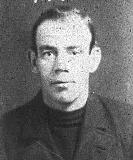

George Robert Hooper, Lance Corporal, 150909, Royal Engineers. George was the son of Richard Henry Hooper and Mary Jane Hooper, of Plymouth. He married Kate West in 1908, and the couple resided at 7, Warwick Road, Milford Haven. George had served with the 1st Volunteer Company, Welsh Regiment for several years, and enlisted at Milford into the Inland Water Transport Company of the Royal Engineers, probably due to his experience working at Milford Docks. He was posted to France on 27 April 1916, where he worked at Dunkirk docks. George is recorded as having died of wounds at Dunkirk on 3 September 1917 after having been struck in the head by shrapnel during bombing of Dunkirk. He was 29 years old, and is buried at Dunkirk Town Cemetery, France.
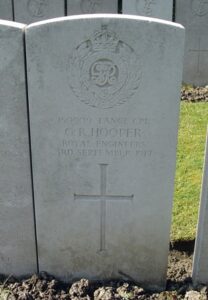
Daniel Hutchison Horne, Private, 11723, Cavalry. Daniel was born at Milford in 1893, the son of George and Agnes Horne. Agnes died in 1902, and George moved the family to 129, Norfolk Street, Mount Pleasant, Swansea. Daniel had enlisted into the 6th Dragoons in June 1911, and was discharged three months later after having been deemed unlikely to become an efficient soldier. He re-enlisted at the outbreak of war, joining the 8th (Kings Royal Irish) Hussars, which was attached to the 9th Cavalry Brigade, 1st Cavalry Division. Daniel joined the Hussars in France in September 1915, and fought there until the Armistice, when the Cavalry Division moved into Germany. Daniel died of influenza while serving as part of the Army of Occupation in Germany on 25 February 1919. He was 26 years old, and is buried at Cologne Southern Cemetery, Germany.
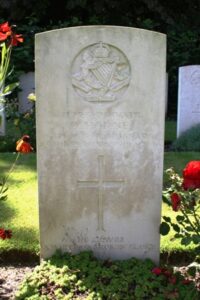
John William Humphries, Third Mate, Mercantile Marine. John was the son of Ellen Louisa Humphries, of 13, Dartmouth Gardens, Milford Haven. He served as Third Mate aboard the SS Bulgarian, a Glasgow registered vessel. John died aged 24 on 20 January 1917, when Bulgarian was sunk by a German submarine. He is commemorated on the Tower Hill Memorial, London.
Reginald Norton James, Engineman, 401ES, Royal Naval Reserve. Reginald, known as Norton, was born on 13 March 1893, the son of Thomas and Martha Jane James, of Pembroke Dock. He lived at 11, Dartmouth Gardens, Milford Haven prior to the war, working as a trawlerman, and was a member of the Royal Naval Reserve, having served previously in the Royal Navy. He re-joined the colours at the outbreak of war and was posted aboard HM Trawler Star of Freedom. On 19 April 1917, Star of Freedom was on patrol off Trevose Head when she struck a mine which had been laid by the German submarine UC-47 and sank with the loss of ten men. Norton was 24 years old and is commemorated on the Plymouth Naval Memorial, Devon. Another Milford man, Joseph Mills, was also lost in the sinking.
Thomas Henry James, Private, 44331, Welsh Regiment. Thomas was the son of Harry and Edith James of 199, Robert Street, Milford Haven. He enlisted at Milford into the Army, and was posted to the 17th Battalion, Welsh Regiment, which formed part of 119 Brigade, 40th (Bantam) Division. This Division was formed between September and December 1915, composed of bantam units and others which had a mixture of regulation-height and shorter men. Weeding out of very under-sized or unfit men delayed the training programme, and it was not until late Spring 1916 that the Division was ready to proceed on active service. The Division moved to France between the 1st and 9th June, and moved to the front near Loos. Late in 1916 they moved south to the Somme, and fought at the Battle of the Ancre, and remained in the area over the winter. In March, 1917 the Germans withdrew to their shortened line, called the Hindenburg Line, and the 40th Division were one of the Divisions that followed the withdrawal. Thomas was killed during this period of stagnant warfare, on 5 September 1917. He was 23 years old, and is buried at Gouzeaucourt New British Cemetery, France.
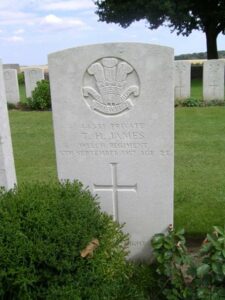
Arthur Merchant Jeffs, Private, 633841, London Regiment. Arthur was the son of Daniel and Ellen Jeffs, of Milford Haven. He enlisted at Milford into the Pembroke Yeomanry, and was posted to the 15th Battalion, London Regiment, before being transferred into the 2/20th Battalion (Blackheath and Woolwich), London Regiment, which was attached to 180 Brigade, 60th Division. The division moved to France in June 1916, but within months was transferred to Salonika. During July 1917 it transferred to Palestine and took part in the Third Battle of Gaza and the capture of Jerusalem. Arthur suffered several bouts of sickness in Palestine, and must have been relieved when the battalion moved to France in May 1918, joining 185 Brigade, 62nd Division. Arthur was killed during the push forward towards the Hindenburg Line on 30 August 1918, during the German counter attacks at Vraucourt and Vaulx-Vraucourt. He was 30 years old, and is buried at Vaulx Hill Cemetery, France.
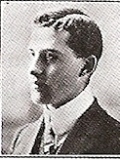
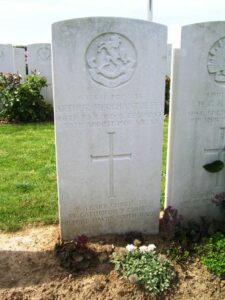
David Thomas Job, Engineman, 84ES, Royal Naval Reserve. David was born on 12 October 1881, the son of John and Elizabeth Job, of Milford Haven, and the husband of Mabel Job, of 43, St Anne’s Road, Hakin. David served as Engineman aboard HM Trawler Lydian, and was killed when she struck a mine and sank off South Foreland on 18 September 1915. David was 35 years old, and is commemorated on the Plymouth Naval Memorial, Devon.
Jack John, Private, 68123, Cheshire Regiment. Jack was the son of Henry and Mary Ann John, of 8, Greville Road, Milford. He enlisted there on 18 March 1918 into the Welsh Regiment. After training he was posted to the 1st Battalion, Cheshire Regiment, which was attached to 15 Brigade, 5th Division. On 14 August 1918 Jack landed in France, joining his new battalion, which was in Reserve. Two weeks later it began its part in the great offensive which forced the German Army into retreat, fighting through Albert (back on the old and devastated Somme ground of 1916), to Irles, and Beugny. Jack was killed during the advance, in the attack on the Canal du Nord, on 27 September 1918, aged 19. He has no known grave, and is commemorated on the Vis-En-Artois Memorial, France.
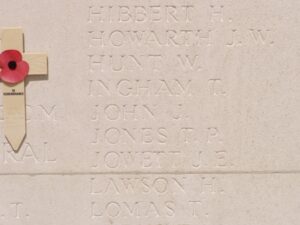
William Arthur John, Private, 79940, Royal Army Medical Corps. William was the son of William and Elizabeth John, of 6, Lower Cromwell Terrace, Priory, Milford Haven. He enlisted at Milford into the Royal Army Medical Corps on 11 December 1915. William served in Britain until being passed fit for overseas service in August 1916, and was posted to the Far East. William arrived at Alexandria in October 1916, then sailed via Suez to Bombay, before being posted to Basra. Little else is known of William, but he died was invalided to India, and died at Deccan War Hospital, Poona on 10 October 1918 aged 22. William is commemorated on the Kirkee 1914-1918 Memorial, India.
John Jones, Deck Hand, 265DA, Royal Naval Reserve. John was born on 19 October 1888, the son of John Jones, of Milford Haven. He resided with his wife, Ethel Jones, at 43, Moffatt Road, Thornton Heath, Surrey during the war, and served as Deck Hand aboard HM Trawler James Hunniford. Little is known of her, but John drowned on 17 June 1918. He was 29 years old, and is commemorated on the Plymouth Naval Memorial, Devon.
John Samuel Jones, Leading Stoker, K/14751, Royal Naval Reserve. John was born on 6 October 1893, the son of John and Martha Jones, of 37, Urban Terrace, Wellington, Shropshire. He served aboard HMS Minotaur, which was an armoured cruiser, which was used mainly for convoy escort duties, but had fought at the Battle of Jutland on 31 May 1916. Little is known of John, or why he is commemorated on the Milford War Memorial, but Minotaur was scrapped at Milford after the war. John died of disease at Milford on 5 July 1918, aged 24, and is buried at Wellington General Cemetery, Shropshire.
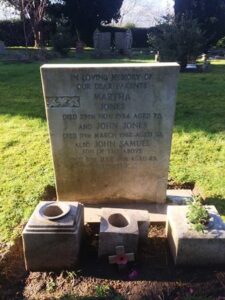
James Frederick Joyce, Gunner, 371334, Royal Garrison Artillery. James was the son of Joseph and Emma Joyce, of Milford Haven. He enlisted at Milford into the Royal Garrison Artillery, and joined its 171st Siege Battery, moving to Italy in 1917. James was fatally wounded on the Italian Front, and died of his wounds on 3 September 1918 aged 21. He is buried at Barenthal Military Cemetery, Italy.
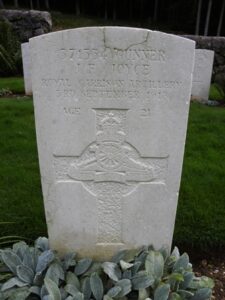
Colin Kerr, Deck Hand, 258DA, Royal Naval Reserve. Colin was born at Glasgow on 29 June 1891. He was based at Milford prior to the war, and resided with Mrs Jane Horst, of 66, Priory Road, Milford Haven. Colin served as Deck Hand aboard HM Trawler Helgian. Colin drowned when Helgian struck a mine in the Aegean and sank on 6 September 1917. He was 26 years old, and is commemorated on the Plymouth Naval Memorial, Devon.
Arthur Gerald King, Private, 39646, Royal Welsh Fusiliers. Arthur was the son of Joseph and Mary Amanda King, of 5, Marble Hall Road, Milford Haven. He enlisted at Milford on 10 December 1915 into the Royal Welsh Fusiliers. At some time during 1916 Arthur was posted to France, joining the 2nd Battalion, Royal Welsh Fusiliers, which was attached to 19 Brigade. The brigade spent the war being posted from one Division to another, and fighting in some of the bloodiest battles of the Western Front. By early 1917 the brigade was attached to 33rd Division, and took part in the Battle of Arras. Arthur was killed at Arras on 27 May 1917, aged just 20. He has no known grave, and is commemorated on the Arras Memorial, France.
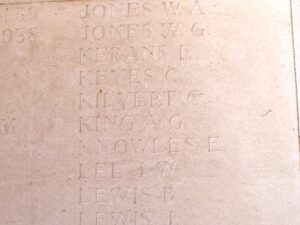
Frederick Palmer Lake, Skipper, Royal Naval Reserve. Frederick was the son of Frederick and Susan Lake, of Brixham, Devon. He married Nellie May Steward whilst based at Milford in 1916. Frederick served as Skipper aboard HMS Prize, and was killed when she was sunk by U-48 on 14 August 1917. Frederick was 25 years old, and is commemorated on the Plymouth Naval Memorial, Devon.
William John Henry Lawrence, Royal Naval Reserve. John was born on 17 February 1895, the son of Thomas Henry Lawrence and Sarah Jane Lawrence, of 19, St Peters Road, Milford Haven. Very little is known of him, but he had served with the Trawler section of the Royal Naval Volunteer Reserve before taking ill, and died on 4 April 1917, aged 22. He is buried in Milford Haven Cemetery. William is not commemorated by the CWGC.
Thomas George Lewis, Private, 76697, Kings Liverpool Regiment. Thomas was the son of George William and Katie Agnes Lewis, of 47, St. Anne’s Road, Hakin. He had originally enlisted into the 4th Welsh, but was then posted to the 23rd Works Battalion, King’s Liverpool Regiment, on Home Service. Thomas died on 21 May 1917 aged just 19, and is buried at Milford Haven Cemetery.
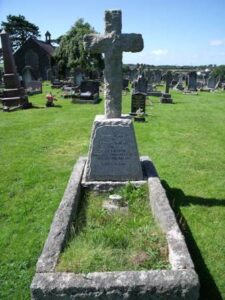
William Henry Lewis, Private, 1228, Welsh Regiment. William was born at Swansea, and must have worked at Milford before enlisting at Cardiff into the 2nd Battalion, Welsh Regiment prior to the outbreak of war. The battalion was one of the first in France, as part of 3 Brigade, 1st Division, fighting at the Battle of Mons, and taking part in the retreat to the Marne, where the Germans were stopped. They then fought at the Aisne, and at Chivy, before being moved north to Ypres. Here they fought at the First Battle of Ypres, where they again stopped the German Offensive, before wintering in Flanders. The following year saw them in action again at the Battle of Aubers, and it was here that William was killed on 2 April 1915. He has no known grave, and is commemorated on the Le Touret Memorial, Richebourg L’Avoue, France.
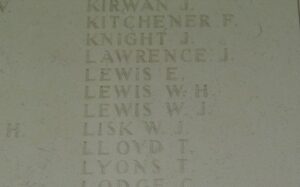
Frederick William Limbrick, Skipper, Royal Naval Reserve. Frederick was born at Brixham, Devon on 20 October 1885, the son of Robert and Elizabeth Limbrick. The family had moved to Milford when Frederick was young, and he grew up there, marrying Margaret Mayberry in 1908, and the couple set up home at Point Villa, Hakin. Frederick served as Skipper aboard HMS Unity, an Acasta Class Destroyer. He unfortunately drowned while being ferried to Unity in a small boat in a gale at Rosslare Harbour on 4 October 1916, aged 30. Frederick is buried at Milford Haven Cemetery.
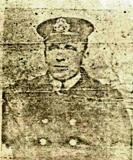
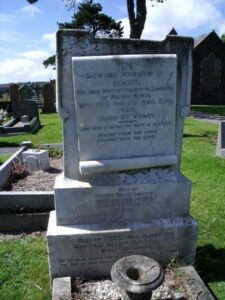
William John Lisk, Private, 14752, Welsh Regiment. William was the son of Stephen and Sarah Lisk, of Swansea. He enlisted into the 3rd Battalion, Welsh Regiment at Swansea on 3 January 1903, and married Elizabeth Ann Maloney in 1906. The couple resided at Milford prior to the war. William was mobilised at the outbreak of war and posted to France with the 2nd Battalion, Welsh Regiment, which was attached to 3 Brigade, 1st Division. The division had been one of the first to arrive in France, fighting at the Battle of Mons, and taking part in the retreat to the Marne, where the Germans were stopped. They then fought at the Aisne, and at Chivy, before being moved North to Ypres. Here they fought at the First Battle of Ypres, where they again stopped the German Offensive, before wintering in Flanders. William was killed during that first winter, on 25 January 1915, aged 32. He is commemorated on the Le Touret Memorial, Richebourg L’Avoue, France.
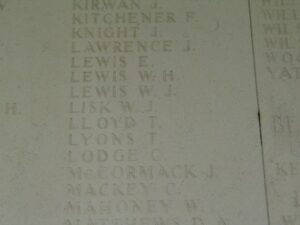
Jonathan James Manthorpe, Deck Hand, 2967DA, Royal Naval Reserve. Jonathan was born at Bermondsey on 29 December 1895, the son of William and Georgina Manthorpe. Jonathan was based at Milford when he married the widowed Alice May Byford (nee Paton), of Beach Road, Pill, Milford Haven. He served aboard the Q-Ship HMS Prize. Jonathan was killed when Prize was destroyed by U-48 on 14 August 1917. He was 20 years old, and is commemorated on the Chatham Naval Memorial, Kent. Alice married Archibald Jennings in 1919, and died in 1981. Her first husband, John Herbert Byford, had been killed in 1915.
William John Marchant, Rifleman, 316215, Monmouthshire Regiment. William was the son of Henry and Sarah Ann Marchant, of 10, Brick Houses, Pill, Milford Haven. He enlisted at Milford into the Army, and joined the 1st Battalion, Monmouthshire Regiment, which was the Pioneer Battalion to the 46th (North Midland) Division. The Division had fought at Loos in 1915 and Gommecourt in 1916, and also at Arras in 1917. Their greatest moment came in 1918 when they took part in the advance to the Hindenburg Line, and captured a vital crossing at Riqueval. William was killed during the advance to the Hindenburg Line on 8 October 1918. He was just 18 years old, and is buried at Sequehart British Cemetery No. 1, Aisne, France.
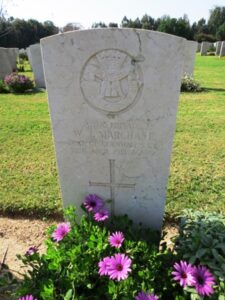
Albert Martin, Stoker 1st Class, K/9641, Royal Navy. Albert was born on 29 March 1888, the son of Richard Edward and Ellen Martin, of 10, Hakinville, Milford Haven. He was a pre-war regular in the Royal Navy, serving aboard HMS Amphion. She was an Active Class light cruiser, and was assigned as leader of the 3rd Destroyer Flotilla with the Harwich Force, defending the eastern approaches to the English Channel. On the afternoon of 5 August 1914, she investigated a trawler, which was acting suspiciously in the English Channel. She turned out to be a German minelayer, and was pursued and sunk by Amphion, in the first naval engagement of the war. After further action against another German vessel, Amphion was returning to Harwich, but struck a mine and sunk on the morning of 6 August 1914. Albert was one of the men killed when the mine exploded, becoming one of the very first British casualties of the Great War. Albert was buried at Shotley (St. Mary) Churchyard, Suffolk. He was 26 years old. Albert was one of four Pembrokeshire men who claim the dubious honour of being the first county casualties of the war.
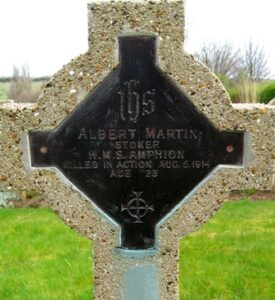
John Lloyd Marvelly, Engineman, 1734ES, Royal Naval Reserve. John was born at Llandeilo on 12 May 1860, and was the husband of Harriet Ann Marvelly (nee Wright), of 26, Dartmouth Street, Milford. He served aboard HM Trawler Lobelia II. John was killed when she struck a mine off Lough Swilly on 19 April 1917. John was 57 years old, and is commemorated on the Plymouth Naval Memorial, Devon.
Clifford Mathias, Private, 14374, Welsh Regiment. Clifford was the son of Jonathan and Emma Jane Mathias, of 9, Murray Road, Pill, Milford Haven. He enlisted at Milford into the 9th Battalion, Welsh Regiment, part of 58 Brigade, 19th (Western) Division. The Division assembled around Bulford during September 1914. Divisional training was completed near Tidworth, from March 1915, and the ‘Butterfly Division’ crossed to France between 11 and 21 July 1915, and moved to positions near Loos. The Division fought during the opening attack of the Battle of Loos, and then moved to the Somme, where they took part in the second wave of the attack on Ovillers-La Boiselle on 1 July, capturing the village at heavy cost. Clifford was killed during the fighting at Ovillers on 7 July 1916, aged 20. He has no known grave, and is commemorated on the Thiepval Memorial, France. He is also commemorated on his parent’s gravestone at Milford Haven Cemetery. His brother Frederick also fell.
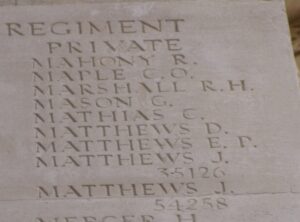
Frederick James Mathias, Second Hand, 1882SA, Royal Naval Reserve. Frederick was born on 3 August 1890, the son of Jonathan and Emma Jane Mathias, of 9, Murray Road, Pill, Milford Haven. He was the husband of Alice Mathias, of Lliswerry, Newport, Monmouth. He served aboard HM Drifter Active III, and was killed when she struck a mine off Milford Haven on 15 October 1917. Frederick was 27 years old and is commemorated on the Plymouth Naval Memorial, Devon. His brother Clifford also fell.
James Hubert Mathias, Private, 14326, Welsh Regiment. James was the son of Arthur and Martha Maria Mathias, of 7, Greville Road, Milford Haven. He enlisted at Milford into the Army, and joined the 11th Battalion, Welsh Regiment, known as the Cardiff Pals, attached to 67 Brigade, 22nd Division. The Division crossed to France in early September 1915, with all units being concentrated near Flesselles by 9 September. However, it’s stay in France was to be very short, as on 27 October 1915 the Division, having been moved by train to Marseilles, began to embark for Salonika. It completed concentration there in November, although the final artillery units were still coming in as late as 13 December 1915. It remained in the theatre for the rest of the war, taking part in the Retreat from Serbia during December, 1915. Between 10 to 18 August 1916 they fought at the battle of Horseshoe Hill, then between 13 to 14 September 1916 at the battle of Machukovo. Between 24-25 April and 8-9 May 1917, the Division fought at the battle of Doiran, and the lines then remained static for several months. James became ill with malaria during this peaceful period, and returned home for treatment, sadly dying on 26 June 1918. He was 31 years old, and is buried at Milford Haven Cemetery.
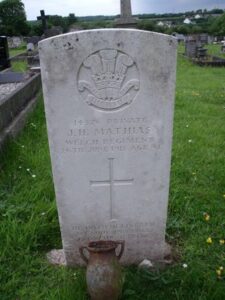
John Mathias, Sergeant, 45, Royal Garrison Artillery. John was the husband of Mary Mathias, of 175, Robert Street, Milford Haven. He had enlisted at Milford into the Royal Garrison Artillery, and joined their Pembroke Company, on Home Defence at Milford. He died of a gastric ulcer on 18 November 1915, aged 41, and is buried at Milford Haven Cemetery. He left his wife and two young children.
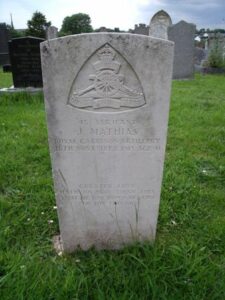
Peter William Webber Medway, Deck Hand, DA/2449, Royal Naval Reserve. Peter was born on 17 April 1887, the son of William and Susan Medway of Brixham, Devon. He had lived at Milford for several years prior to the war, and resided with his wife Annie Catherine Medway, at 10, Vicary Street Pill, Milford Haven. He served aboard HM Trawler Evangel, and was drowned when she hit a mine of St. Anne’s Head and sank on 25 March 1917. Peter was 29 years old, and is buried at Milford Haven Cemetery.
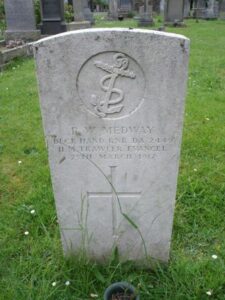
Maurice Miller, Gunner, 371383, Royal Garrison Artillery. Maurice was the son of Mr. and Mrs. George Miller, of 90, Charles Street, Milford Haven. He enlisted at Milford into the Royal Garrison Artillery, and joined their newly formed 68th Siege Battery. The Battery moved to France in March 1916, and fought through the Somme offensive. It then moved north to support the Battle of Arras, and it was at Arras that Maurice was killed on 30 April 1917. He was 21 years old, and is buried at Ste. Catherine British Cemetery, France.

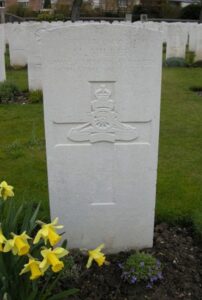
Hubert Ernest Mills, Engineman, 2504ES, Royal Naval Reserve. Hubert was born on 25 August 1877, the son of William and Jane Mills, of Hubberston. He lived prior to the war with his wife, Mary Mills, at Broadway, Little Haven. Hubert was a Royal Naval Reservist, and served during the Great War aboard HM Trawler Fulmar. Fulmar was a Grimsby-registered 231-ton vessel, which had been built in 1899 and hired in May 1915 by the Admiralty. She was sunk by a mine on 17 Jan 1916 in the Gulf of Sollum, with the loss of all hands. Hubert was 38 years old, and is commemorated on Panel 19 of the Plymouth Naval Memorial, Devon.
Joseph Mills, Private, 5892, Welsh Regiment. Joseph was the son of John and Jane Mills, of Woodland, Little Haven, and the cousin of Albert Mills, who also fell during the war. He enlisted at Milford into the 4th Battalion, Welsh Regiment, but was later posted to the Labour Corps, with the army number 483046. Joseph died whilst on home service, on 15 November 1918. He was 31 years old, and is buried at Milford Haven Cemetery. Photograph courtesy of Ray Constance.
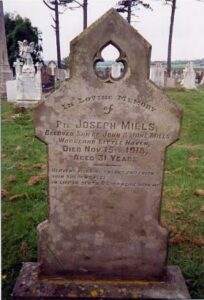
William Henry Miners, Skipper, 101SA, Royal Naval Reserve. William was born in Truro, Cornwall on 30 November 1882, the son of William and Alice Miners. He had lived at Milford for many years prior to the war, working as a fisherman, and had married Caroline Edwards in 1908, residing with his wife at 2, Marble Hall, Milford Haven. He served in the Merchant Fleet, but was attached to the Royal Naval Reserve, as Skipper aboard HM Trawler Norman II, which was taken over by the Admiralty in 1915 for use as a Minesweeper. William died of tubercular peritonitis at Stonehouse Naval Hospital, Plymouth on 18 April 1918, aged 35. He is buried at Ford Park Cemetery, Devon.
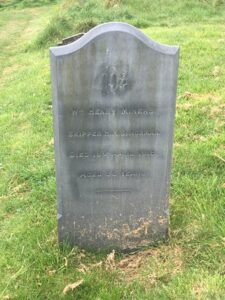
Arthur George Munning, Bombardier, 371111, Royal Garrison Artillery. Arthur was born in 1897, the son of Harriet Munning, of 173, Church Road, Gorleston, Norfolk. He had moved to Hakin with his brother William prior to the war, and enlisted there into the 68th Siege Battery, Royal Garrison Artillery. He moved to France with it in March 1916, and fought through the Battles of the Somme, Arras and Passchendaele. Arthur was killed in action during the German Spring Offensive on the Somme on 5 April 1918. He is buried at Ribemont Communal Cemetery Extension, Somme, France. His brother William died of wounds in June 1917. Many thanks to Joanne Rees for the photograph of Arthur.
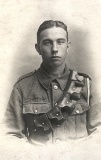
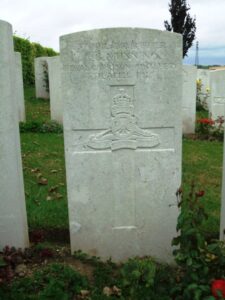
William James Munning, Deck Hand, 9838DA, Royal Navy. William was born on 6 May 1894, the son of Harriet Munning, of Gorleston, and the Brother of Frank Harcourt Munning C.B.E., and of Hannah Munning, of Rosebury House, Gorleston, Norfolk. A resident of Hakin, he served as Deck Hand aboard HMPMS Redcar. Redcar was a Paddle Minesweeper, and was based at Dover. William was badly wounded when Redcar struck a mine off Gravelines on 24 June 1917, and died the following day. He was buried at Dunkirk Town Cemetery, France. His younger brother Arthur was killed in 1918, while serving with 68th Siege Battery, RGA. Many thanks to Joanne Rees for the photograph of William.

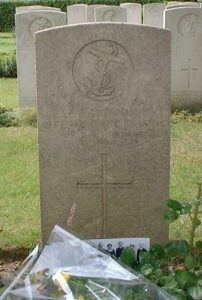
Richard Nichols, Private, 1822, Irish Guards. Richard was the son of George and Ellen Nichols, of Plymouth. He had worked at Milford Docks for several years prior to the war, residing at 25, Dartmouth Gardens, Milford Haven. Richard travelled to Waterford to enlist into the Irish Guards. At the outbreak of war, Richard was with their 1st Battalion, attached to 4th (Guards) Brigade, 2nd Division. One of the first Divisions to move to France, the 2nd Division remained on the Western Front throughout the war. They moved to Belgium, where they fought at the Battle of Mons, and retreating southwards, fought at the Affair of Landrecies, the Rearguard Actions of Villers-Cotterets, and at the Battle of the Marne where the German offensive was stopped. The Germans retreated north, and the BEF met them, fighting at the Battle of the Aisne. The 2nd Division were then moved to Flanders, where they fought at the First Battle of Ypres, when the German sweep through Flanders was stopped. Richard was killed at Ypres on 26 October 1914, aged 29. He is commemorated on the Ypres (Menin Gate) Memorial, Belgium.
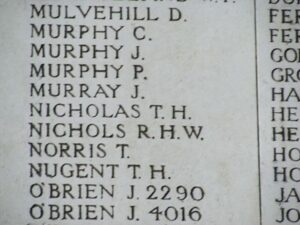
Frederick Charles Noakes, Private, 40718, Cheshire Regiment. Frederick was the son of David Noakes and Martha Noakes (nee Devonald), of 104, Charles Street, Milford Haven. He was conscripted in May 1916 and appealed, but lost his case, so on 12 December 1916 he attested at Milford into the Cheshire Regiment. He was sent to Carmarthen to undergo his medical before being sent to Kinmel Park for training. Frederick embarked for France on 27 March 1918 and was posted to the 9th Battalion, Cheshire Regiment, which was attached to 56 Brigade, 19th (Western) Division. The Battalion had just suffered terrible casualties during the opening phase of the German Spring offensive on the Somme when the Division was hit near Gaika Copse on 21 March 1918, before being forced into a fighting rear-guard action over the coming days. Frederick was among a large draft of reinforcements posted to the 9th Cheshire’s as the battalion rested and refitted at Ramillies Camp over the coming days. The battalion then moved to the Messines sector with the 19th Division, to hold a quieter sector of the line as rebuilding was completed. Unfortunately, the Germans launched the second phase of their offensive along the Lys Valley on 9 April 1918 and the 19th Division became caught up in desperate fighting once more. Frederick was fatally wounded by bullets in the neck and spine during heavy fighting near Nieppe on the following day, 10 April, and was evacuated via the 76th Field Ambulance to the 35th General Hospital at Calais for treatment, where he sadly died of his wounds on 16 April 1918, aged just 20. Frederick is buried at Les Baraques Military Cemetery, Sangatte, France.
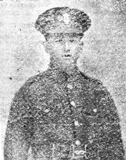
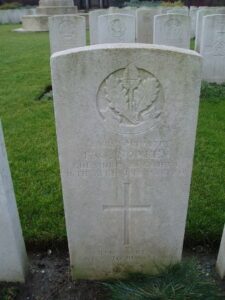
Reginald Norman, Private, 200616, Welsh Regiment. Reginald was the son of Samuel and Elizabeth Norman, of 13, Ingate Street, Beccles, Suffolk. He lived at Milton prior to the war, and enlisted at Fort Hubberston into the 1/4th Battalion, Welsh Regiment, the local Territorial unit. The battalion formed part of 159 Brigade, 53rd (Welsh) Division, and landed on Gallipoli in August 1915, remaining there until the evacuation. It then fought in Egypt, and took part in the advance into Palestine in March 1917, remaining there for the duration of war. Reginald was wounded soon after the Division had taken part in the capture of Jerusalem, and died of his wounds on 3 January 1918. He was 19 years old, and is buried at Kantara War Memorial Cemetery, Egypt.
Alfred George Owen, Private, 534892, London Regiment. Alfred was the son of William John Owen and Mary Ann Owen, of Parkhurst, 20, Waterloo Road. He worked as an Income Tax Clerk at Cardiff prior to the war, and enlisted there into the 2/15th Battalion (Prince of Wales Own Civil Service Rifles), London Regiment, which formed part of 179 Brigade, 60th (2/2nd London) Division. The Division fought in Salonika for much of the war, but on 30 May 1918 Alfred’s Battalion left the Division and moved to France, arriving at Audruicq by 22 June, and joining 90 Brigade, 30th Division, which had been decimated during the German Spring Offensives. In August the Allies gained a huge victory over the Germans at Villers Brettoneux on the Somme, and from then on, they were on the offensive. The 30th Division took part in the Advance in Flanders, which is where Alfred was killed on 3 October 1918. He was 21 years old, and is commemorated on the Tyne Cot Memorial, Belgium.
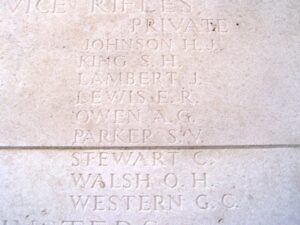
James Owen, Gunner, 371069, Royal Garrison Artillery. James was born at Steynton, the son of John and Mary Ann Owen. He worked as a mason prior to enlisting at Milford into the Royal Garrison Artillery, joining the 68th Siege Battery. The Battery landed in France on 31 March 1916, and took part in the Somme Battles, before moving to the Arras Sector. James was killed during the Battle of Arras on 30 April 1917, aged 23. He is buried at Ste. Catherine British Cemetery, France.
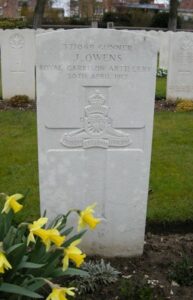
Charles Picton Owens, Engineman, 4846ES, Royal Naval Reserve. Charles was born on 1 March 1890, the son of Thomas and Anne Owens, of 40 Prendergast, Haverfordwest. Prior to the war he resided with his wife Lilian Owens, at 12, City Road, Haverfordwest. He served as Engineman aboard HM Drifter Active III, and was drowned when she struck a mine off St. Anne’s Head on 15 October 1917. Charles was 27 years old and is commemorated on the Plymouth Naval Memorial, Devon.
Henry Paxton Palmer, Pioneer, 46356, Royal Engineers. Henry was born on 8 May 1897, the son of Robert Paxton Palmer and Amelia Palmer, of 8, Bridge Street, Hakin. He enlisted at Milford into the Royal Engineers and was posted to their 23rd Signal Company, which was attached to the 1st Division. The Division saw action during the epic retreat from Mons, and at First Ypres during 1914. In 1915 it fought at Loos, and was on the Somme in 1916. In the spring of 1917 the Division moved to Flanders, and it was here that Henry was killed on 27 May 1917. He was 20 years old, and is buried at Railway Dugouts Burial Ground, Belgium.
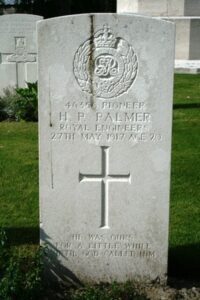
William Walter Payne, Engineman, 331ES, Royal Naval Reserve. William was born on 21 April 1881, the son of Frank Payne, of Bristol. He married Edith Matilda Owens in 1906, and the couple resided at 5, Priory Terrace, Milford Haven, with their three children. William was serving as Engineman aboard HM Trawler Apley, when she struck a mine off the Isle of Wight on 6 December 1917 and sank with all hands. William was 35 years old and is commemorated on the Plymouth Naval Memorial, Devon.
William Martin Peterson, Corporal, 3772, London Regiment. William was the son of John and Mary Peterson, of Milford Haven. He enlisted at Milford into the Army, and was posted to the 14th Battalion (London Scottish), London Regiment, attached to 168 Brigade, 56th (London) Division. The Division were on the Somme in 1916, and fought at the diversionary attack on Gommecourt then at Ginchy, Flers and Morval, where they captured Combles. William was killed on the Somme on 22 October 1916. He was 26 years old, and is buried at Maroeuil British Cemetery, France.
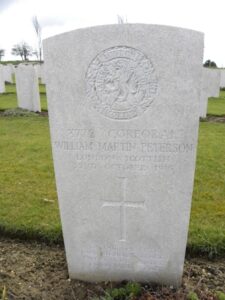
James Charles Phillips, Skipper, Royal Naval Reserve. James was the son of Lewis and Sarah Phillips, of 15, Chapel Street, Milford Haven. He lived with his wife Annie Phillips at 186, Robert Street, Milford Haven prior to the war. James served as Skipper aboard HM Trawler Lydian, and was killed when she struck a mine and sank off South Foreland on 15 September 1915. James was 31 years old and is buried at Milford Haven Cemetery.
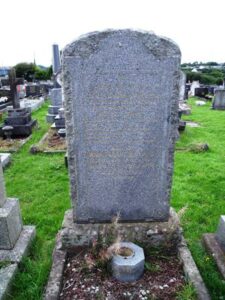
William Richard Picton, Deck Hand, 14850DA, Royal Naval Reserve. William was born on 23 July 1889, the son of Richard William Picton of Milford Haven. He was the husband of Florence Mary Picton, of 14, Clarence Street, Pembroke Dock. He served as Deck hand aboard HM Drifter Active III, and was killed when she sank after striking a mine off Milford Haven on 15 October 1917. William was 28 years old and is commemorated on the Plymouth Naval Memorial, Devon.
Walter Bartholomew Potter, Able Seaman, Royal Naval Reserve. Walter was the son of Charles and Annie Potter, of Wilton, Wiltshire. For several years prior to the war he had resided with his wife Ethel Mary Potter, at 4, Brick House, Pill, Milford Haven. Walter served with the Royal Naval Reserve, aboard the S.S. Duckbridge, a Newcastle registered merchant steamer. On 22 February 1916 Duckbridge was on route with a cargo of Welsh steam coal for the British fleet from Cardiff to the Orkneys, when she struck a mine and sank off Straithie Point. Walter was 34 years old when he died that day, and is commemorated on the Tower Hill Memorial, London.
Cyril Powell, Gunner, 371234, Royal Garrison Artillery. Cyril was the son of George and Sarah Powell, of 184, Robert Street, Milford Haven. He enlisted at Milford into the Royal Garrison Artillery, and joined its 354th Siege Battery. The Battery landed in France on 22 May 1917, and fought at Third Ypres later that year. It was on the Somme by the summer of 1918, and was supporting the Australian and Canadian offensive near Villers Brettoneux when Cyril was killed on 11 August 1918. He was 19 years old, and is buried at Heath Cemetery, Harbonnieres, France.
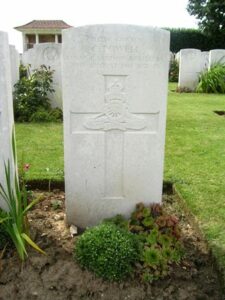
Josiah Pratt, Skipper, Royal Naval Reserve. Josiah was the son of Thomas and Mary Ann Pratt, of Sculcoates, Yorkshire and the brother-in-law of Susan Mary Pratt, of 4, Milton Terrace, Pill, Milford Haven. He served as Skipper aboard HM Trawler Lobelia II, and was killed when she struck a mine off Lough Swilly on 19 April 1917. Josiah was 48 years old, and is commemorated on the Plymouth Naval Memorial, Devon.
William Rackley, Mate, Mercantile Marine. William was the son of John and Elizabeth Rackley, of Brixham, Devon. He married Susan Avery Michelmore in 1883, but she sadly died just three years later. William had served at sea for many years prior to moving to Milford by 1911. When war was declared William was posted aboard the Brixham registered Fishing Vessel Friendship, which was owned by Tom Jenkerson of Milford. On 13 February 1917 Friendship was working off The Smalls when she was captured by the German submarine UC-65, and the crew of four took to the life raft. They were never picked up, and the Friendship was scuttled. William was 57 years old when he died and is commemorated on the Tower Hill Memorial, London.
Archibald Radmore, Skipper, Royal Naval Reserve. Archibald was born on 7 August 1875, the son of George and Louisa Radmore of Milford Haven. He had married Jane Maria Knight at Milford in 1900, after the death of his first wife Helen. Archibald served as Skipper aboard HM Trawler Blacklyn, which had been converted for minesweeping duties. Archibald died aboard Blacklyn when she struck a mine, which had been laid by the German submarine UC1, and blew in half on 11 May 1917. He was 41 years old and is buried at Lowestoft (Beccles Road) Cemetery.
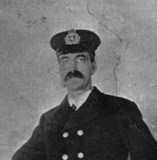
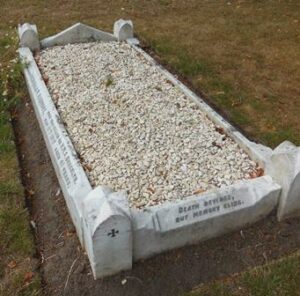
James Rimmer, Deck Hand, 8735DA, Royal Naval Reserve. James was born in Fleetwood on 11 April 1883, the son of Thomas Rimmer (a fisherman), and the stepson of Margaret Alice Rimmer (nee Greenish). He was married to Sarah Alice Rimmer (nee Scotton), and had five children; William F, Mildred, Mary Ellen, Eva D and Agnes A, who all lived in 12, Prospect Place, Milford Haven. James served aboard HM Drifter Pearl III, which was a hired net drifter, which was active in the Gallipoli Campaign. James died on active service on 17 December 1915, and is commemorated on the Plymouth Naval Memorial, Devon. Many thanks to Sian Moran for the information.
James David Rees Roberts, Petty Officer 2nd Class, 147492, Royal Navy. James was born on 9 March 1873, the son of David and Emma Roberts of Hubberston. He was the husband of Mary Roberts, of 41, Shakespeare Avenue, Milford Haven. James was a long serving regular in the Royal Navy, being awarded the China Medal, for the 1900 campaign, and was the holder of the Long Service and Good Conduct Medal. James was posted to HMS Laurentic during the Great War, and was sadly among the men drowned when she struck a mine of the North Irish coast on 25 January 1917. He was 43 years old, and is commemorated on the Plymouth Naval Memorial, Devon.
Henry Rooke, Skipper, Royal Naval Reserve. Henry was born in Cardiff on 1 May 1890. He probably moved to Milford to work as a fisherman and in 1913 married Mary Elizabeth Devonald, of 35, Dartmouth Street, Milford Haven. He served aboard HM Trawler Dragon II during the war. Henry took ill and died of influenza and pneumonia on 8 October 1918 whilst at Dublin. He is buried at Dean’s Grange Cemetery, Dublin.
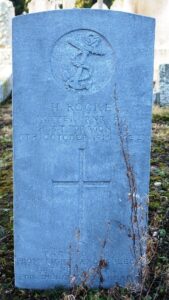
George Joseph Rudge, Cook, Mercantile Marine. George was the son of Joseph and Susan Rudge of Hull. He resided at Milford prior to the war with his second wife, Annie Rudge (nee Lawson). George served as Cook aboard the Steam Trawler Victoria, a Fleetwood registered vessel. He was killed on 1 June 1915 when Victoria was attacked and shelled by a German U-Boat. George was 56 years old and is commemorated on the Tower Hill Memorial, London.
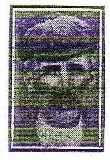
Frederick George Scotton, Sergeant, 32653, Royal Garrison Artillery. Frederick was the son of George Henry and Elizabeth Jane Scotton (nee Summons), of Marble Hall Terrace, Milford Haven. He enlisted at Milford into the newly formed 137th Siege Battery. Royal Garrison Artillery. The battery moved to France during August 1916, at the height of the Somme offensive. It is not known what happened to Frederick, but he died during the time of the Battle of Arras, on 26 April 1917 in Hospital at Etaples. He was 29 years old and buried at the vast Étaples Military Cemetery, France.
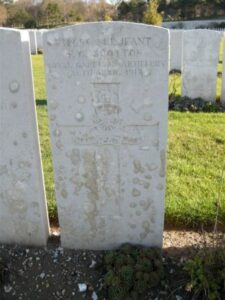
William Albert Shoebottom, Trimmer Cook, 500TC, Royal Naval Reserve. William was born on 5 November 1881, the son of William and Harriett Shoebottom, of Birmingham. He worked as a fisherman at Milford for several years prior to the war and resided with his wife Helen Shoebottom, at 6, Wellington Avenue, Hakin, Milford Haven. He served as Trimmer Cook aboard HM Trawler Merse, and was killed when she struck a mine of the West Coast of Scotland on 22 May 1917. William was 35 years old, and is commemorated on the Plymouth Naval Memorial, Devon.
Daniel John Smith, Bombardier, 25374, Royal Garrison Artillery. Daniel was the son of Herbert and Elizabeth Smith, of Matson Lane, Gloucester. He had been based with the Royal Artillery in Pembrokeshire for several years prior to the war, marrying Margaret Alice McKay, of 10, Priory Villa, Milford Haven in 1912. Daniel moved to France attached to the 95th Siege Battery, Royal Garrison Artillery. Daniel was killed soon after arriving in France, during the Battle of the Somme on 31 July 1916. He was 26 years old, and is buried at Bronfay Farm Military Cemetery, Bray Sur Somme, France.
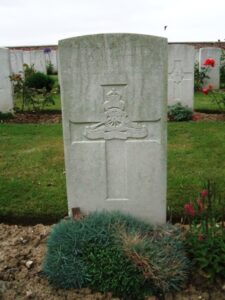
Ernest Smith, Private, 44669, Welsh Regiment. Ernest was the son of James and Almenia Smith, of 18, Trafalgar Road, Milford Haven. He worked at Cardiff prior to the war and married Christina Annie Clarke on 24 May 1916. Ernest joined the Welsh Regiment at Cardiff, and was posted to the 12th Welsh at Kinmel Park. He was then posted to the 11th Battalion, Welsh Regiment, which was called the Cardiff Pals, and was part of 67 Brigade, 22nd Division. The Division crossed to France in early September 1915, with all units being concentrated near Flesselles by 9 September. However, it’s stay in France was to be very short, as on 27 October 1915 the Division, having been moved by train to Marseilles, began to embark for Salonika. It completed concentration there in November, although the final artillery units were still coming in as late as 13 December 1915. It remained in the theatre for the rest of the war, taking part in the Retreat from Serbia during December, 1915. Between 10 to 18 August 1916 they fought at the battle of Horseshoe Hill, then between 13 to 14 September 1916 at the battle of Machukovo. Between 24-25 April and 8-9 May 1917, the Division fought at the battle of Doiran, and then on 18 September 1918 at the Second Battle of Doiran. Ernest died of wounds suffered at Doiran on 28 September 1918 aged 23. He is buried at Mikra British Cemetery, Kalamaria. His widow remarried, and became Mrs. C. A. Haselgrove-Spurin, of Old Post Office, Taffswell, Cardiff.
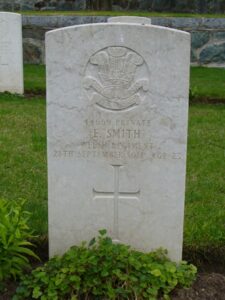
Harry James Smith, Second Hand, 1231SA, Royal Naval Reserve. Harry was born on 4 July 1891, the son of Edward Smith, of 15, New Street, Plymouth. He resided with his wife Frances Maria Smith at 12, Vicarage Street, Pill, Milford Haven. Harry served aboard HM Trawler Senator, and was killed when she struck a mine off the North coast of Ireland on 21 May 1917. Harry was 26 years old, and is commemorated on the Plymouth Naval Memorial, Devon.
Benjamin Arthur James Stanfield, Deck Hand, 2767DA, Royal Naval Reserve. Benjamin was born on 17 February 1899, the son of James and Mary A. Stanfield, of 34, St. Anne’s Road, Hakin, Milford Haven. He served aboard HM Trawler Evangel, and was killed when she struck a mine in the English Channel on 25 March 1917 and was lost with all hands. Benjamin was 18 years old, and is commemorated on the Plymouth Naval Memorial, Devon.
John James (Stevo) Stevenson, Skipper, Mercantile Marine. John was known locally as Stevo. He was the husband of Minnie Stevenson (nee Gray), and resided at 32, St. Anne’s Road, Hakin. Stevo was the Skipper of the Steam Trawler Victoria, a Fleetwood registered vessel. He was killed on 1 June 1915 when Victoria was attacked and shelled by a German U-Boat. Stevo was 39 years old and is commemorated on the Tower Hill Memorial, London.
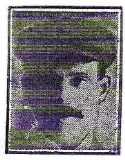
Sidney Stratford, Deck Hand, 2929DA, Royal Naval Reserve. Sidney was born at Grimsby on 7 November 1888, the of Sidney Daniel and Annie Eliza Stratford. His parents had moved to Hubberston by 1891, and Sidney later became a fisherman. During the war he served aboard HM Trawler Lobelia II. She had been requisitioned by the Admiralty and converted for minesweeping duties. On 19 April 1917 Lobelia II was on patrol when she struck a German laid mine and sank with all hands. Sidney was 28 years old when he died that day, and is commemorated on the Plymouth Naval Memorial, Devon.
William Edward Sweeny, Private, 14758, Machine Gun Corps. William was the son of Thomas and Edith Sweeny, of Marble Hall Terrace, Hakin. He married in 1907 and lived with his wife Eveline Sweeny at 56, Cambrian Road, Neyland. William had served overseas with the Machine Gun Corps, but had been gassed at Loos, returning home for hospital treatment. William died at Milford as a result of being gassed on 10 April 1917, aged 31. He is buried at Milford Haven Cemetery.
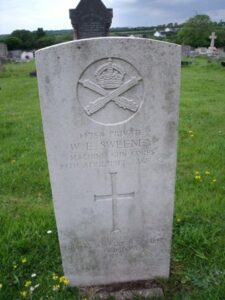
Arthur Laing Tait, Deck Hand, 1142SD, Royal Naval Reserve. Arthur was born on 11 December 1894 at Lerwick, the son of Andrew and Mary Tait. He was the husband of Mabel Tait, of 2, Marshall Place, Blackhall, Edinburgh. Arthur served aboard HM Trawler Emley. She had been requisitioned by the Admiralty and converted for minesweeping duties. On 28 April 1918 Emley was on patrol in the South Channel, off May Island, when she struck a mine which had been laid by the German U-Boat OC-40 and sank with all hands. Arthur was 23 years old and is commemorated on the Portsmouth Naval Memorial, Hampshire.
Thomas Vaux Taylor, Skipper, Royal Naval Reserve. Thomas was born at Aberdeen on 30 October 1886. He was probably a fisherman based at Milford prior to the war, and in 1909 he married Emily Gwendoline Pettit. He served as Skipper of HM Trawler Stelma, which was based in Dorset. Thomas suffered an accident soon after the war, falling and breaking his spine, and died in hospital at Portland on 3 February 1919, aged 32. He is buried at Portland Royal Naval Cemetery, Dorset.
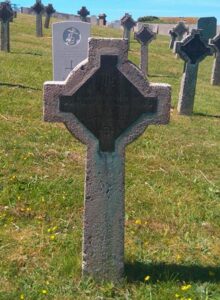
Albert James Thomas, Private, 26567, Royal Fusiliers. Albert was the son of Arthur and Mary Thomas, of 27, Priory Road, Milford Haven, and enlisted at Milford into the Army. Albert was posted to the 7th Battalion, Royal Fusiliers, part of 190 Brigade, 63rd (Royal Naval) Division. The Naval Brigades were originally sent to Antwerp and Dunkirk in September and October, 1914 to guard against invasion by the Germans. However, Antwerp fell to the Germans soon after, and so many of the RND units were withdrawn to England. After a lengthy period of refit and training the Division moved to Egypt preparatory to the Gallipoli campaign. Landing on 25 April 1915, the Division fought throughout the Campaign on Gallipoli. They were transferred from the authority of the Admiralty to the War Office on 29 April 1916, and was re-designated the 63rd (Royal Naval) Division on 19 July 1916. The Division moved to France, arriving at Marseilles between 12 and 23 May 1916 and moved to positions on the Somme, where it took part in the Battle of the Ancre, which is where Albert was killed on 13 November 1916. He was 25 years old, and is buried at Ancre British Cemetery, Beaumont Hamel, France.
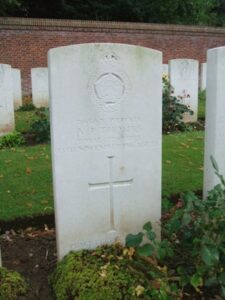
Charles Edward Thomas, Petty Officer Stoker, 1356U, Royal Naval Reserve. Charles was born on 27 April 1879, the son of Daniel H. and Sarah E. Thomas, of Milford Haven. He was the husband of Harriet Ann Thomas, of 3, Concrete Cottages, Pill, Milford Haven. He served aboard HM Trawler Helgian, and was killed when Helgian struck a mine in the Aegean and sank on 6 September 1917. Charles was 38 years old, and is commemorated on the Plymouth Naval Memorial, Devon.
George Harding Thomas, Rifleman, King’s Royal Rifle Corps. George was the son of Charles Howard Thomas, of Marine Gardens, Milford. He enlisted into the army at the start of the war, and was posted to France on 17 November 1915 with the 16th Battalion, King’s Royal Rifle Corps, which was attached to 100 Brigade, 33rd Division. George was badly wounded after being struck by shrapnel during November, and returned to England, where he was hospitalised at Poole. After recovery he moved to Winchester Barracks, before being sent back out to France early in 1916. George was wounded again on the Somme in July 1916, and again returned home for treatment, before being discharged as medically unfit. He then worked in a munitions factory, and in the summer of 1918 married Margaret M Davies, of Aberdare, at Milford. During 1918 the young couple were both struck down with influenza, and George died. He was 26 years old, and was buried with full military honours in Milford Haven Cemetery. He is not eligible for commemoration by the CWGC.
James George Thomas, Bombardier, 371331, Royal Garrison Artillery. James was the son of John and Elizabeth Thomas, of Fair View, Priory Hill, Milford Haven. He enlisted at Milford into the Pembrokeshire Battery, Royal Garrison Artillery. James joined its 11th Siege Battery, and moved to France on 21 April 1915. James probably served through the Battles of Loos, and at the Somme in 1916, before being killed during the Battle of Arras on 24 May 1917. He has no known grave, and is commemorated on the Arras Memorial, France.
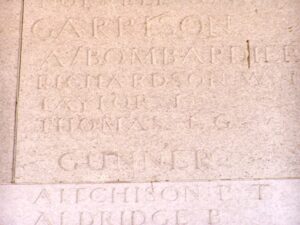
James Henry (Harry) Thomas, Lance Corporal, 17430, Royal Fusiliers. Harry was born at St. David’s, the son of Dorothy Thomas. His father died when he was young, and Dorothy married William Orchard in 1899. The family moved to 1, Priory Hill, Milford Haven, where Dorothy gave birth to several other children, and Harry was raised as William’s own son. He enlisted at Haverfordwest into the Army, and was posted to France at some time in 1916, joining the 1st Battalion, Royal Fusiliers, which was attached to 17 Brigade, 6th Division. Harry probably saw his first action on the Somme, at the Battle of Flers-Courcelette, the Battle of Morval and the Battle of Le Transloy. The following year saw the division at Arras, where it fought at the Battle of Hill 70, and then during the Battle of Cambrai later in the year. In the spring of 1918 the Division was one of those hit by the German Offensive on the Somme, which had been launched on 21 March, and the Division took part in the Battle of St Quentin. Harry was killed during the build up to the German offensive, on 8 March 1918, aged 23. He is buried at Tincourt New British Cemetery, France.
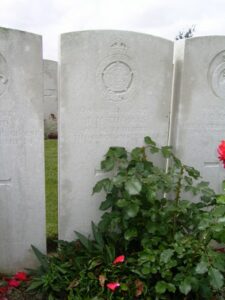
John Thomas, Second Hand, 2295SA, Royal Naval Reserve. John was born at Milford Haven on 7 June 1876, and was the husband of Minnie Thomas, of 126, Severn Grove, Canton, Cardiff. He served aboard HM Drifter Boy Harold, and was killed aboard her when she was lost with all hands after striking a German mine on 3 March 1916. John was 39 years old, and is buried at Bari War Cemetery, Italy.
Albert Henry Tucker, Skipper, Mercantile Marine. Albert was the son of John and Eliza Jane Tucker, of Brixham, Devon, and the husband of Miriam Berry Tucker, of 43, Dewsland Street, Milford Haven. He was Skipper of the ‘Friendship’, and was drowned when she was sunk by a German submarine on 13 February 1917. Albert was 42 years old, and is commemorated on the Tower Hill Memorial, London.
Lawrence Vaughan, Air Mechanic 2nd Class, 20264, Royal Air Force. Lawrence had married Lilian Elsie Limbrick in 1912, and the couple lived at 122, Priory Road, Milford. He enlisted into the Royal Air Force, and after training as an Air Mechanic, Lawrence was posted to 79 Squadron in France, which flew the Sopwith Dolphin. Until the end of the war it carries out fighter patrols and ground attack missions with Dolphins and after the Armistice moved to Germany as part of the occupation forces, disbanding there on 15 July 1919. Lawrence died in Germany of influenza on 5 February 1919. He is buried at Cologne Southern Cemetery, Germany.
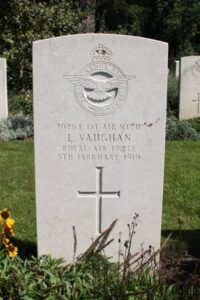
William Herbert Vincent, Deck Hand, 681DA, Royal Naval Reserve. William was born on 26 October 1895, the son of Alice Knight (formerly Vincent), of Lower Drang, Hakin, Milford Haven. He served as Deck Hand aboard HMS Prize, a ‘Q-Ship’ commanded by William Sanders, VC. William was killed when Prize was sunk in action against a German submarine in the Atlantic, on 14 August 1917. He was 21 years old, and is commemorated on the Plymouth Naval Memorial, Devon.
Bernard Westenborg, Gunner, 20282, Royal Garrison Artillery. Bernard was the son of Bernard and Mary Westenborg, of Wellington Road, Hakin, Milford Haven. Bernard worked on the Swansea Trawlers and Fish market prior to the outbreak of war, and enlisted at Swansea into the Royal Garrison Artillery, being posted to their 17th Heavy Battery in France. Little is known of Bernard’s service, but he was killed in action on the Somme on 8 August 1916. He was 30 years old, and is commemorated on the Thiepval Memorial, France.
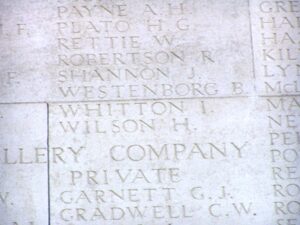
Albert George Wiles, Trimmer Cook, 4773TS, Royal Naval Reserve. Albert was born on 24 June 1897, the son of George and Gertrude Wiles, of 4, Warwick Road, Milford Haven. He served as Trimmer Cook aboard HM Trawler Lord Airedale. Albert lost his life when Lord Airedale struck a mine and sunk off Harwich on 29 November 1916. He was 19 years old, and is commemorated on the Plymouth Naval Memorial, Devon. His brother Wilfred also fell.
Wilfred John Wiles, Private, 41796, South Wales Borderers. Wilfred was the son of George Criton Wiles and Gertrude Wiles, of 4, Warwick Road, Milford Haven, and enlisted at Carmarthen into the Training Reserve. Wilfred was posted to France, probably early in 1918, joining the 2nd Battalion, South Wales Borderers, which was attached to 87 Brigade, 29th Division. The German Spring Offensive hit the British on the Somme on 21 March 1918, and hit in Flanders just weeks later. The 29th Division fought at the desperate defensive battles of Estaires, Messines, Bailleul and Kemmel, before the war turned in favour of the Allies after a series of successes on the Somme in August. The Division then took part in the Offensive in Flanders, where they took part in the Action of Outtersteene Ridge, and then at the Battle of Ypres and the Battle of Courtrai. Wilfred was fatally wounded during the final stages of the war. He died of his wounds on 8 October 1918 aged 19 and is buried at Terlincthun British Cemetery, Wimille, France. His brother Albert also fell.
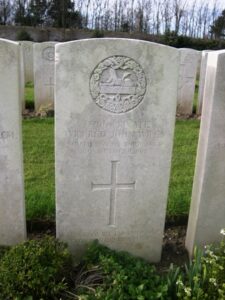
Ivor Carlyle Williams, Private, 66193, Cheshire Regiment. Ivor was born at Hubberston in 1899, the son of John and Eleanor Williams. The family later resided at 11, William’s Street, Pontardulais prior to the war, and Ivor worked in a Tinplate Works. He enlisted at Ammanford on 12 June 1915 into the 15th Battalion, Welsh Regiment, which was known as the Carmarthen Pals Battalion. He was discharged on 5 October 1915 due to being under-age. Ivor re-enlisted at Swansea in February 1917, and was posted to the 9th Battalion, Cheshire Regiment, attached to 56 Brigade, 19th (Western) Division. Ivor joined the battalion in France on 24 January 1918. In the Spring of 1918 the division was caught up in the German Spring Offensive on the Somme, and was decimated, before being moved to positions near Ploegsteert to rest and rebuild. Fatally, they were hit again, by a fresh offensive in April, and during the desperate fighting that followed in the Battle of Kemmel, Ivor was fatally wounded in the thigh and arms by gunshot. He died of his wounds, aged just 19, on 29 April 1918, and is buried at Esquelbecq Military Cemetery, France.
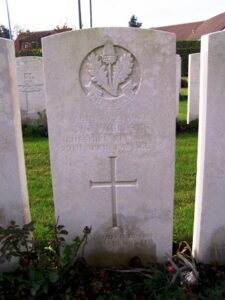
John Williams, Private, 26566, Royal Fusiliers. John was born at Abercastle, Mathry in 1892. For several years prior to the war he had resided with his Uncle and Aunt, Lori and Mary Adams, at 3, Coombs, Milford Haven. John enlisted at Milford into the Army, and was posted to the 8th Battalion, Royal Fusiliers, which were attached to 36 Brigade, 12th (Eastern) Division. The Division landed at Boulogne on 31 May 1915, and took over the line at Ploegsteert Wood. They then moved south and fought in the Battle of Loos, and the subsequent actions of the Hohenzollern Redoubt, and remained there until March 1916. By June they were in position at the Somme, and attacked Ovillers on 2 July. They fought at Pozieres and Le Transloy, which is where John was badly wounded. He was evacuated to the military hospital at Boulogne for treatment, but sadly died of his wounds there on 7 October 1916, aged 24. John is buried at Boulogne Eastern Cemetery, France.
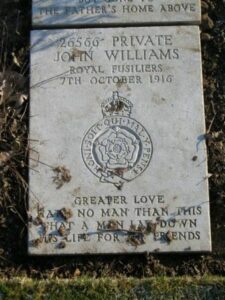
W. John Williams, Trimmer, 2805TS, Royal Naval Reserve. John was born at Tenby on 26 October 1897, the son of William Williams. The family later moved to 7, Point Street, Hakin, Milford Haven. John served aboard HM Trawler Fulmar. He was killed when Fulmar struck a mine and sank in the Gulf of Sellum on 17 January 1916. John was 18 years old and is commemorated on the Plymouth Naval Memorial, Devon.
Gilbert John Wilson, Deck Hand, 15235DA, Royal Naval Reserve. Gilbert was born on 24 December 1891, the son of Gilbert John Wilson, of Brixham, Devon. He had worked at Milford for several years prior to the war, and resided with his wife Gertrude Wilson, at 15, Albion Street, Milford Haven. He was another of the crew of HMS Prize, and died when she was sunk in action against German submarine U-48 in the Atlantic on 14 August 1917. Gilbert was 25 years old, and is commemorated on the Plymouth Naval Memorial, Devon.
David Joseph Wood, Private, 267198, Royal Warwickshire Regiment. David was born in 1893, the son of Richard and Sarah Ann Wood, of 29, Newgate Street, Llanfaes, Brecon. He worked as a miner prior to enlisting at Wrexham in March 1914 into the 3rd Battalion, South Wales Borderers. David was discharged at Pembroke on 23 October 1914 as being medically unfit. He married Ellen Thomas early in 1915, and the couple resided at Fern Cottage, Johnston. David re-enlisted at Milford into the Welsh Regiment, and was one of several local men posted to the 2/7th Battalion, Royal Warwickshire Regiment, part of 182 Brigade, 61st (2nd South Midland) Division. The Division had been in France since 21 May 1916, moving to positions at Fromelles, where it was virtually decimated. Such was the damage to the Division that it was not used again other than for holding trench lines until 1917, when it followed the German withdrawal to the Hindenburg Line, capturing Chaulnes and Bapaume. Later that year it fought at Battle of Langemarck, as part of the Third Battle of Ypres, and in late August and early September it was involved in the efforts to push the line forward at positions around Schuler Farm and Aisne Farm near Kerselaar. The Division then moved south, where it was to take part in the Battle of Cambrai. 61st Division was initially held in reserve and was still in the area when the enemy made a determined counterattack on 30 November. The Division was ordered up to reinforce the units under attack in the area of La Vacquerie and for some days was involved in a hard fight to stem the enemy attack. During March, 1918 the Division was holding the forward zone of defences in the sector northwest of Saint Quentin, in the area of Ham and lost many men as it fought a chaotic but ultimately successful withdrawal back over the Somme crossings over the next ten days. David was one of many men lost in the first days of this terrible fighting. He was killed in action on 22 March 1918, aged 25, and is commemorated on the Pozières Memorial, France. (David is named on the memorial as D. J. Thomas)
